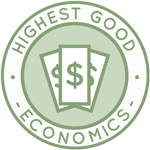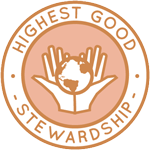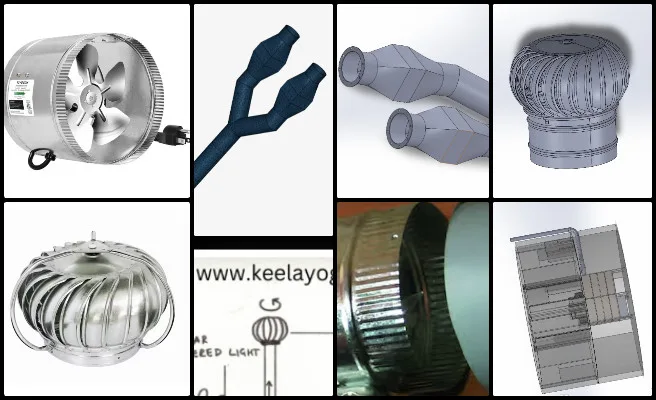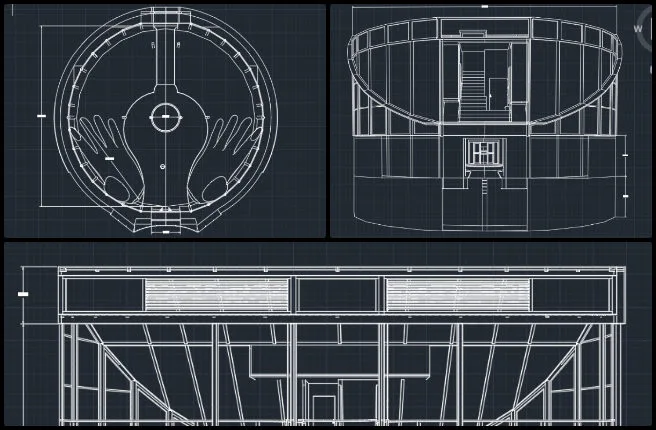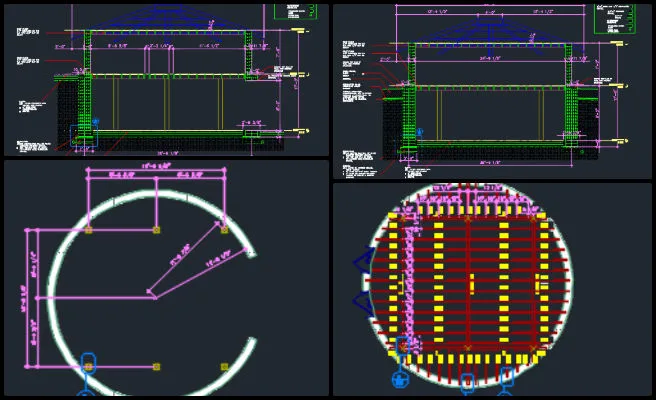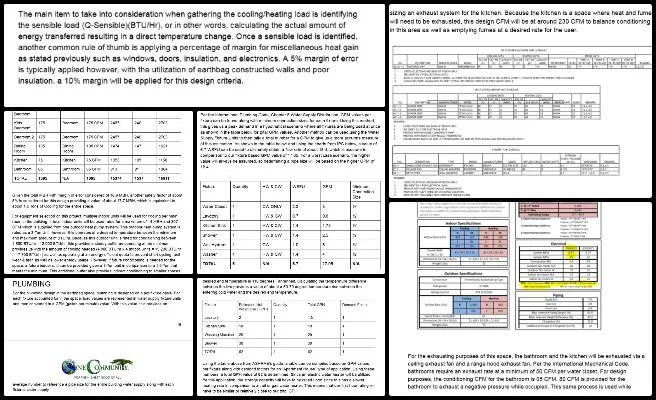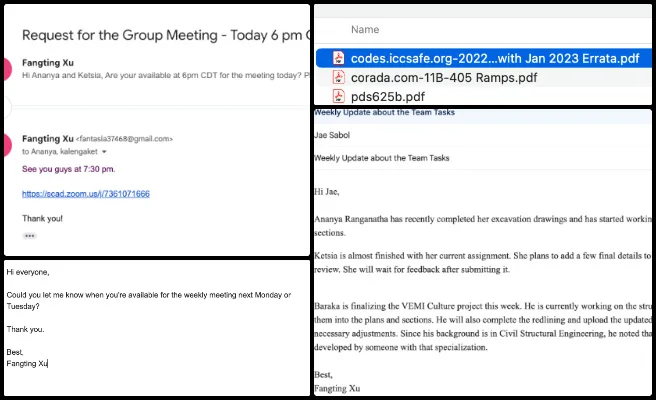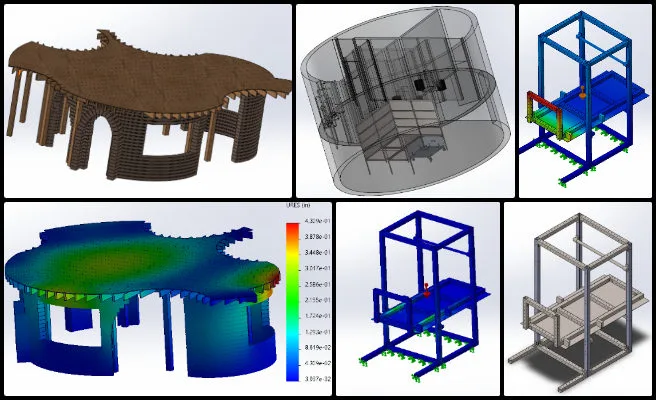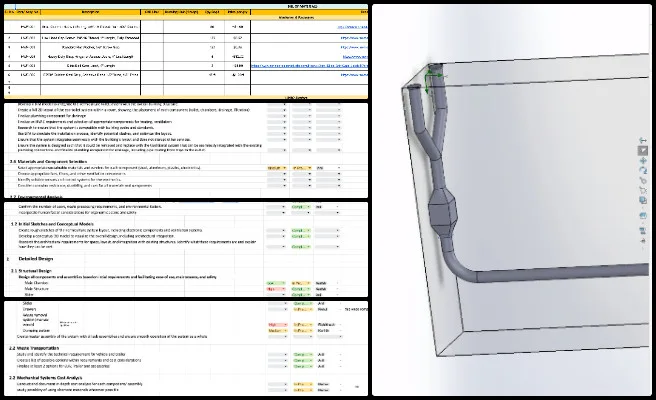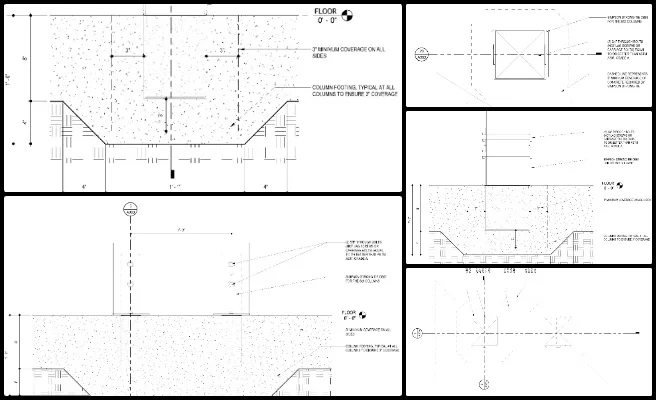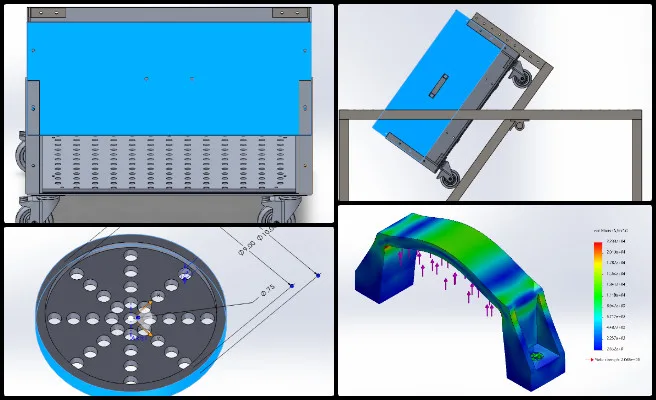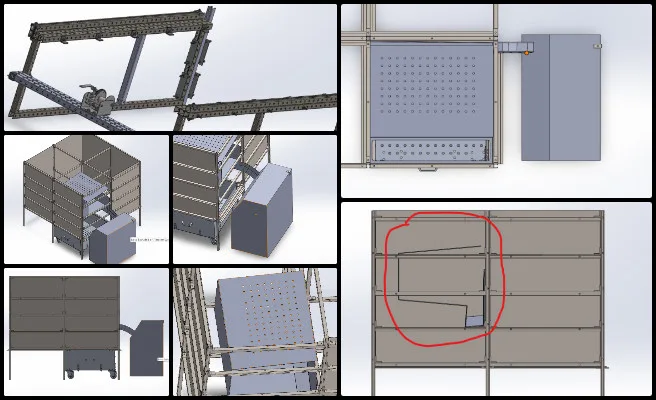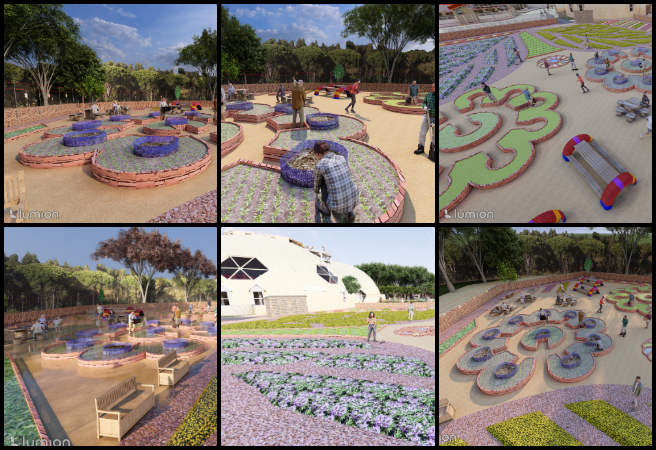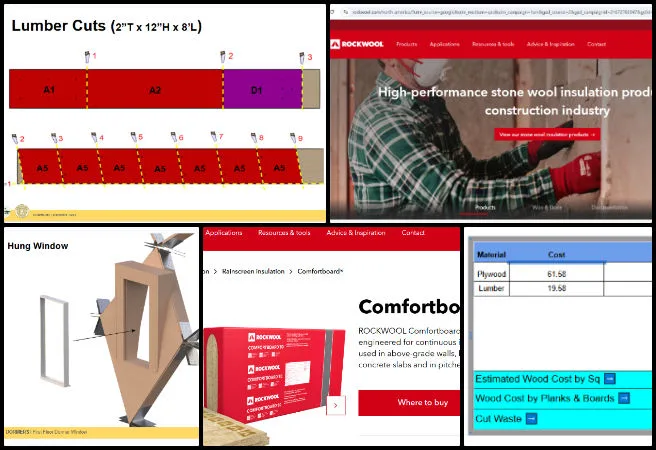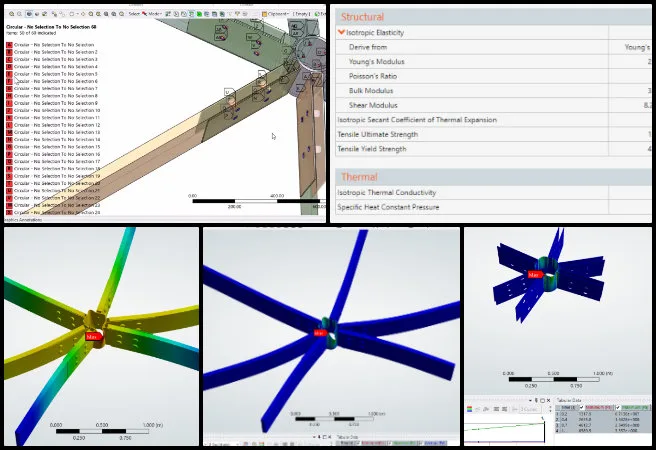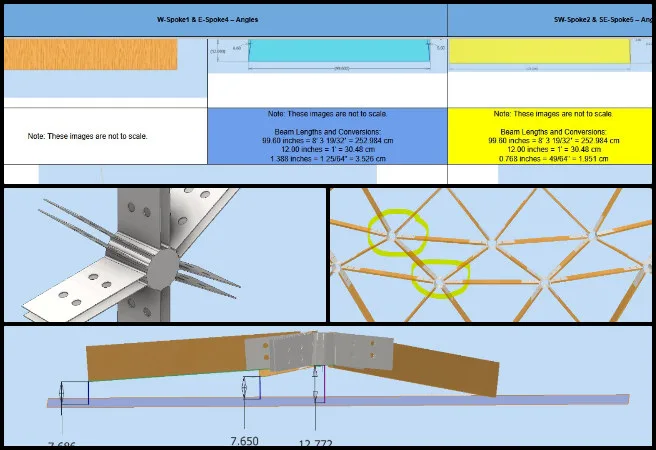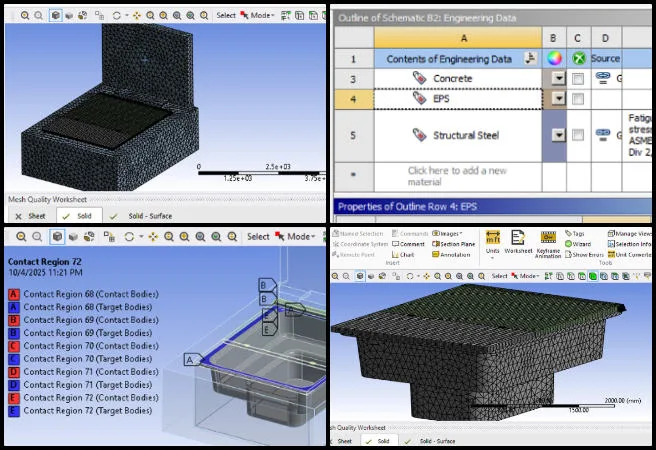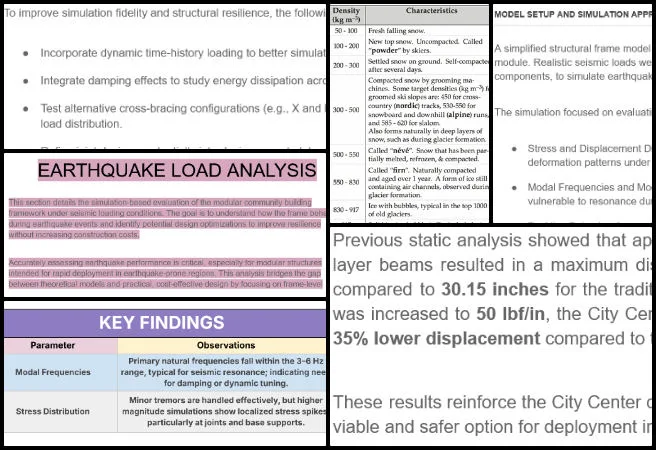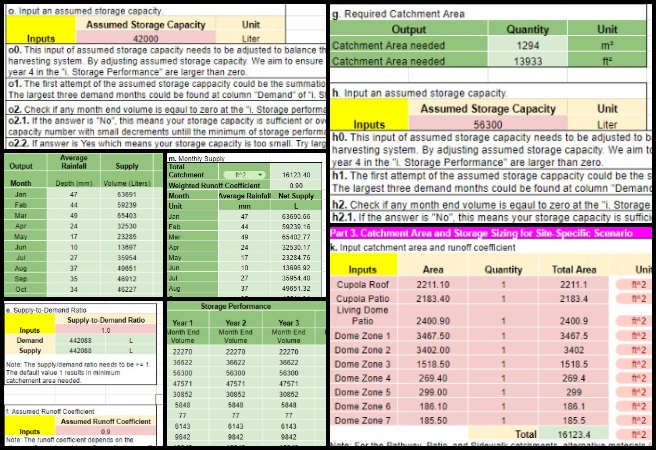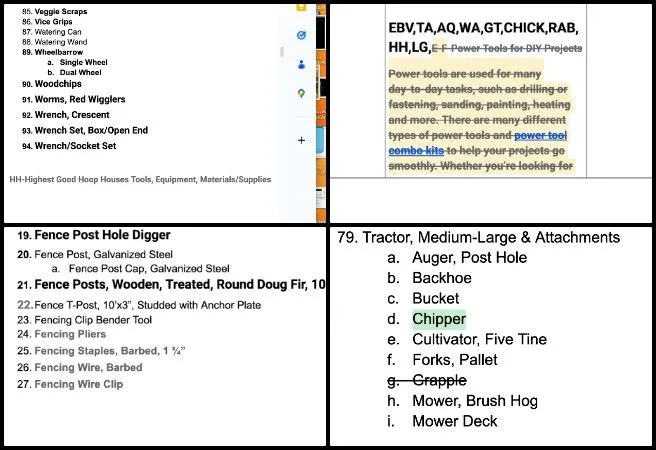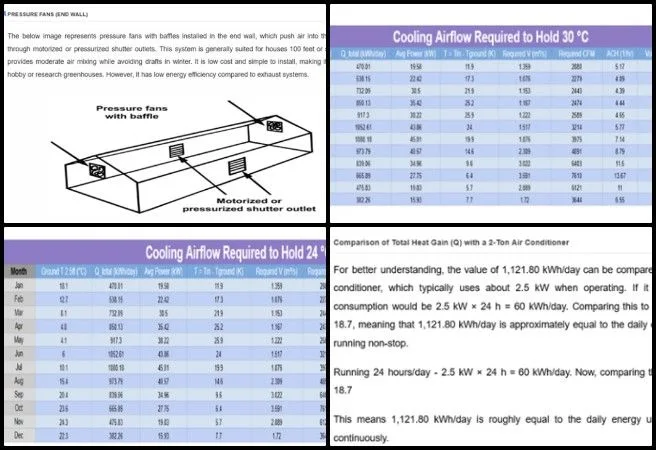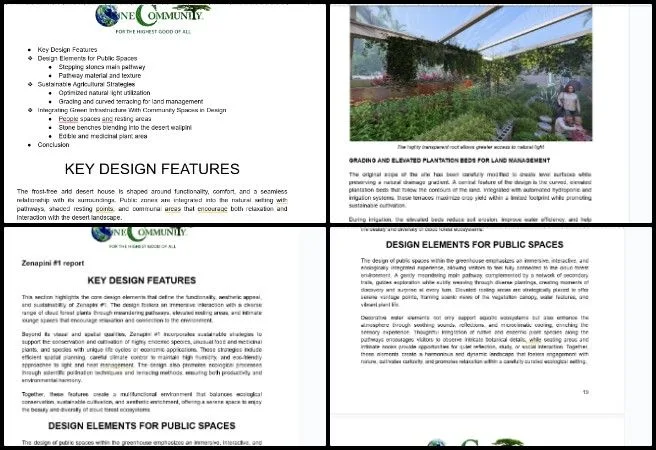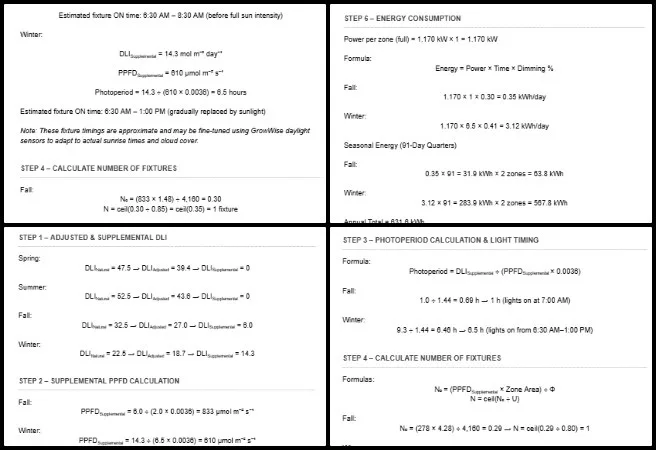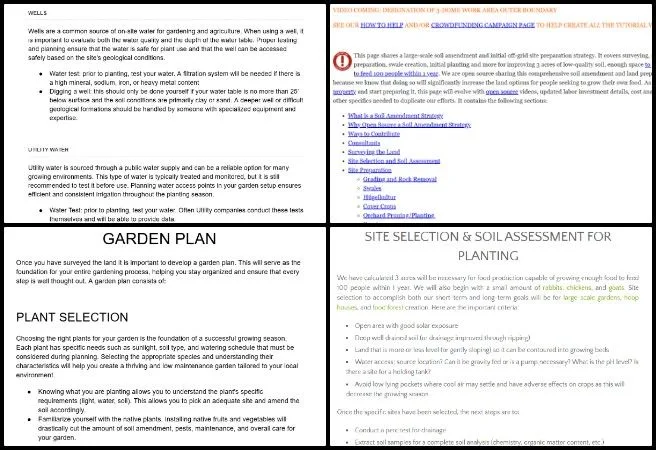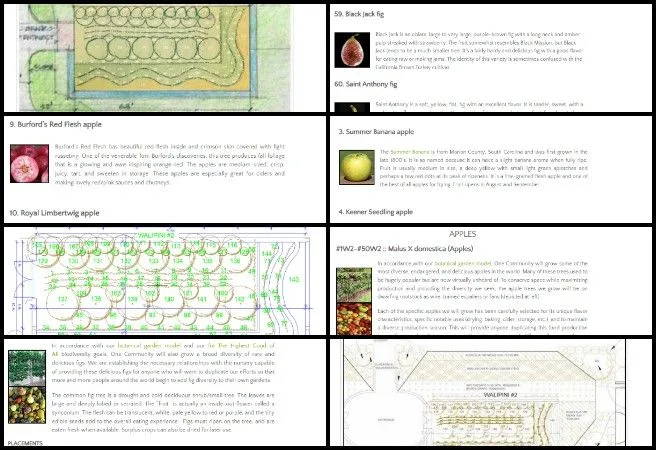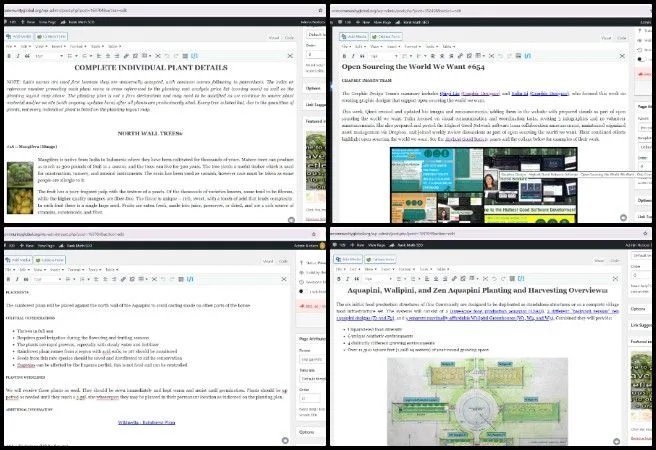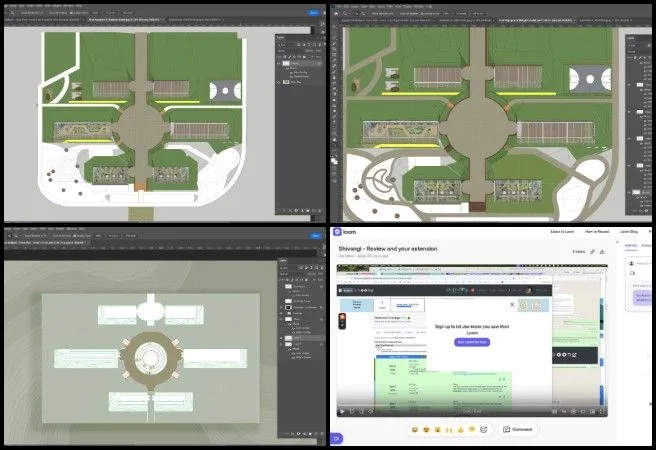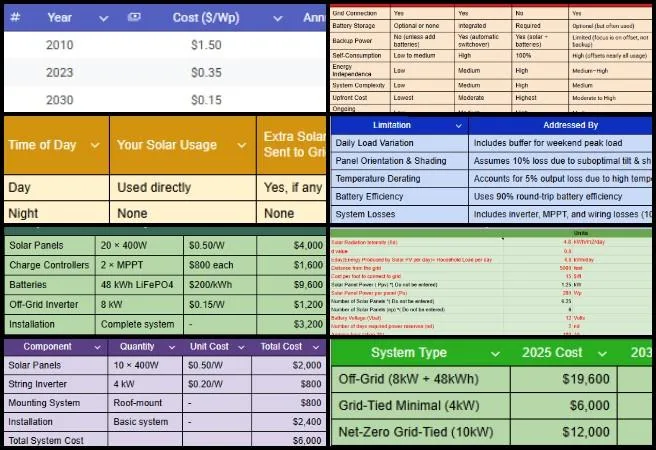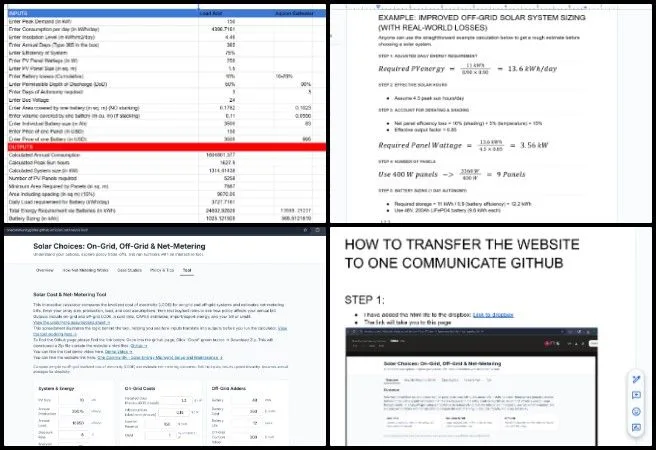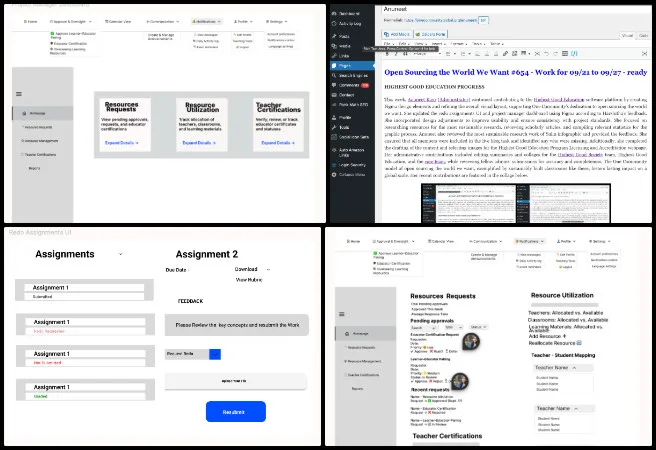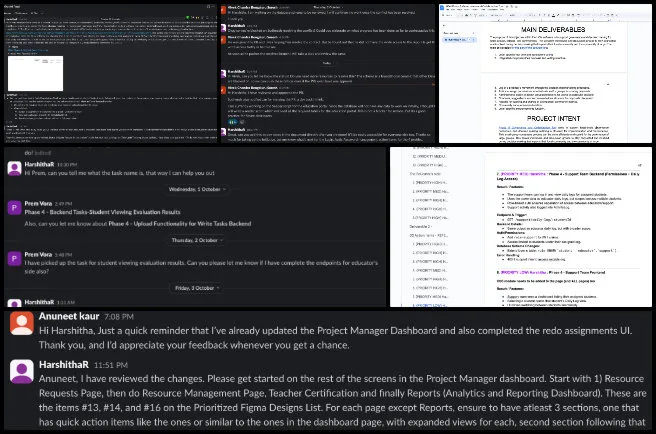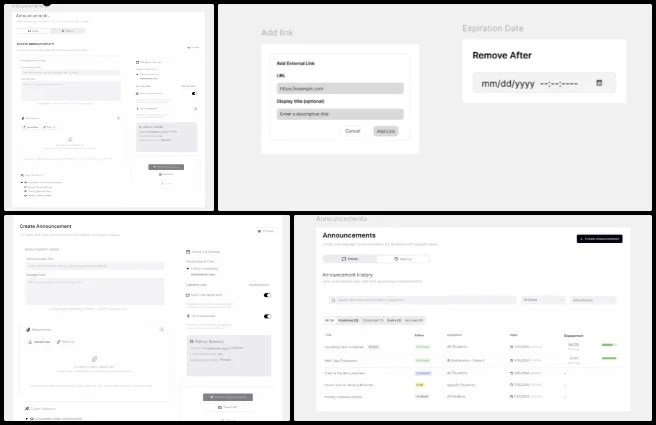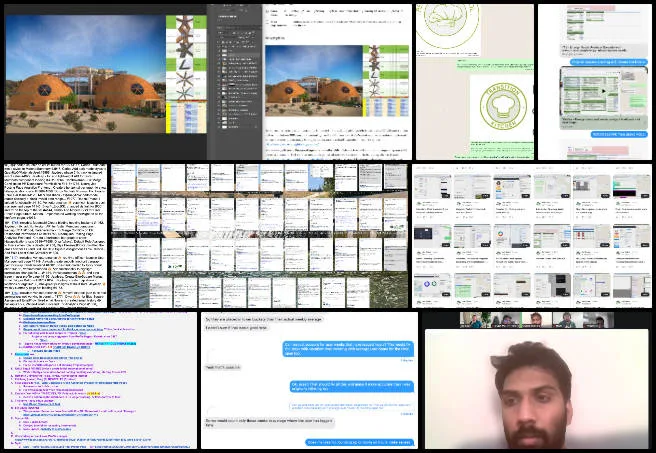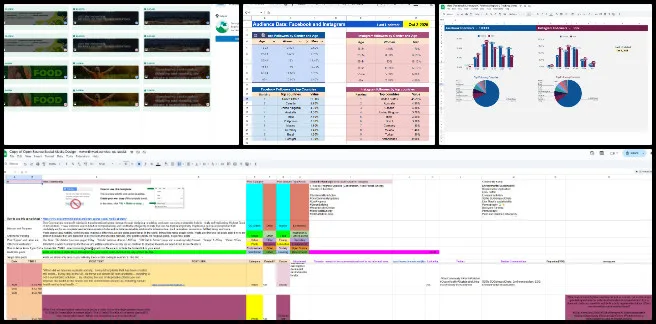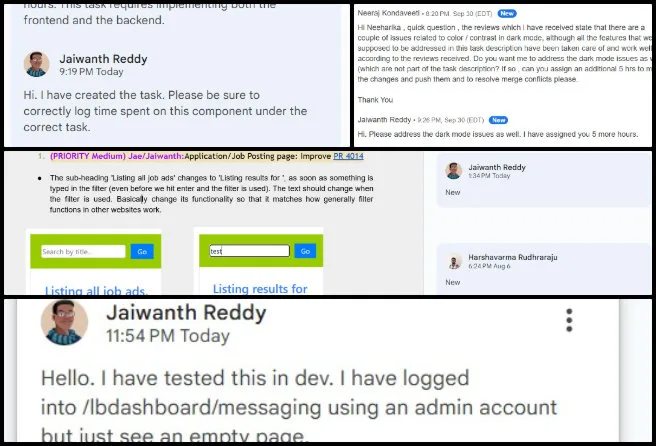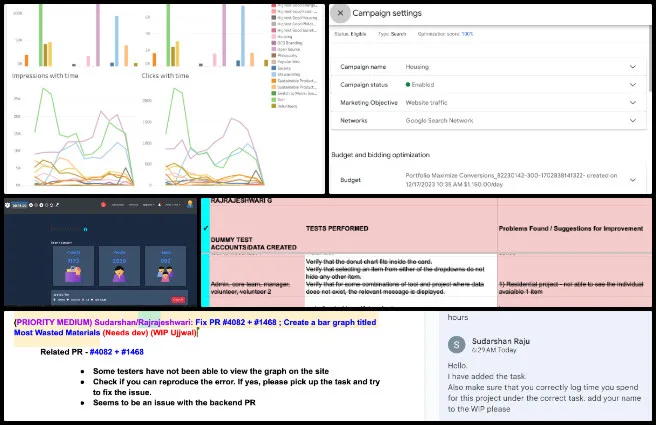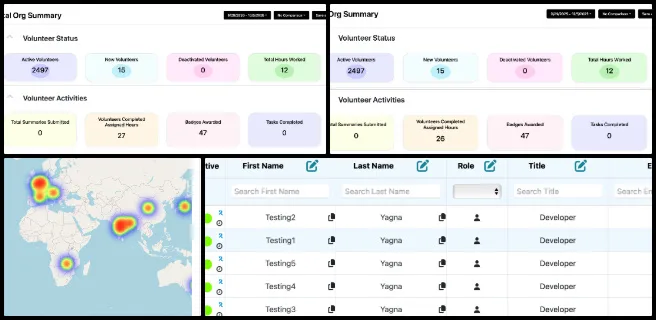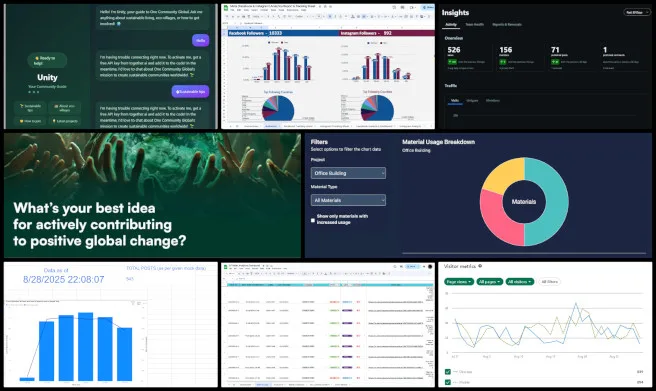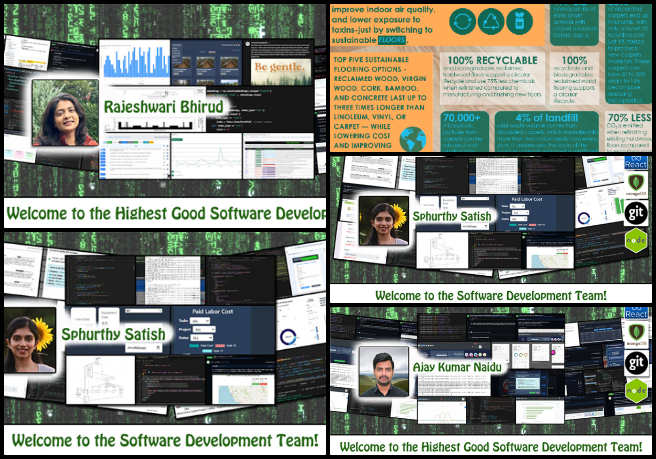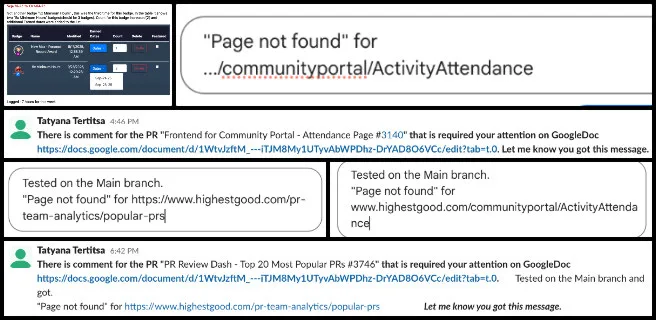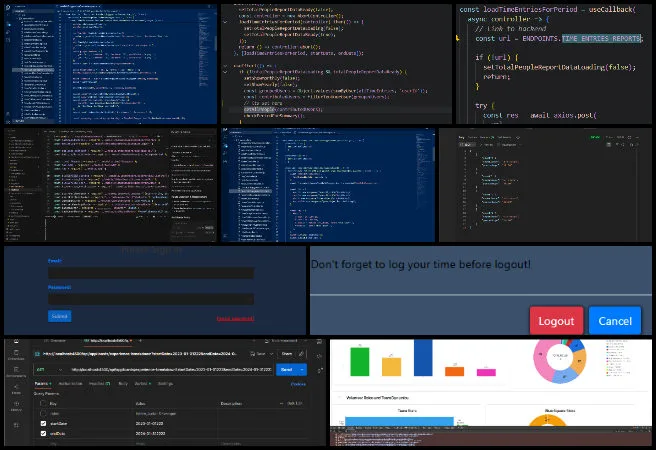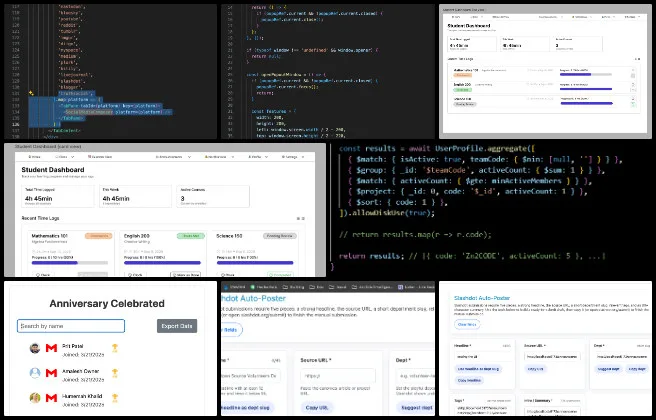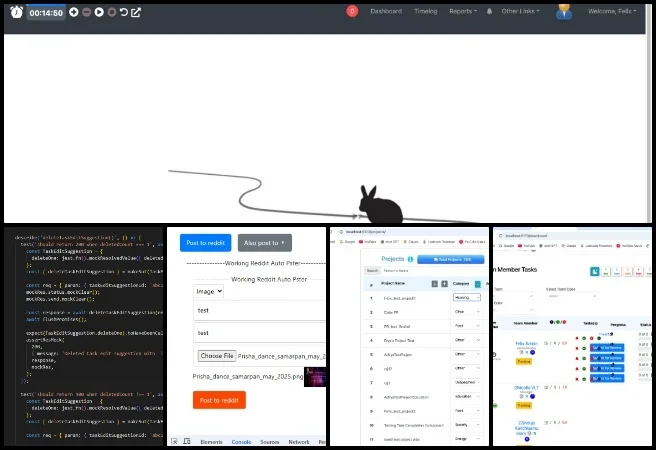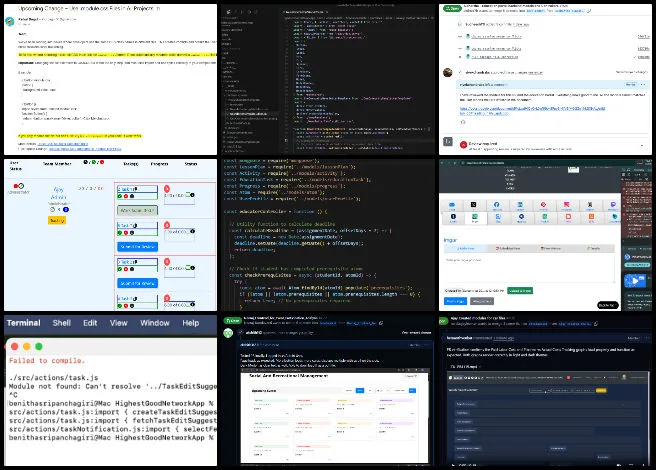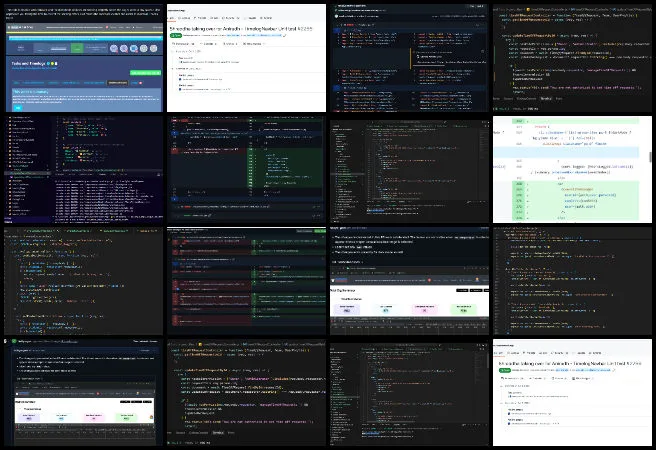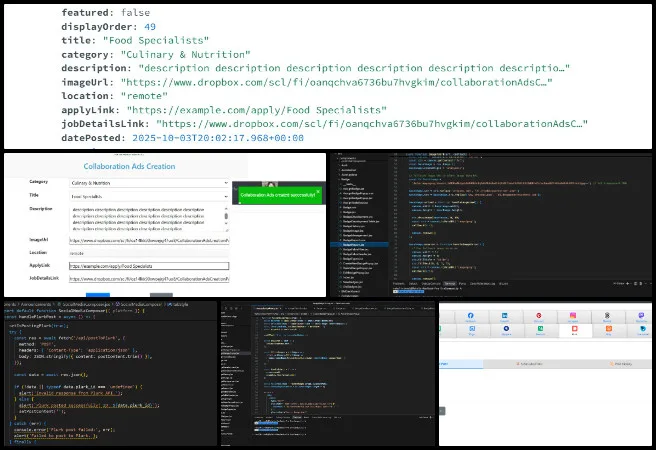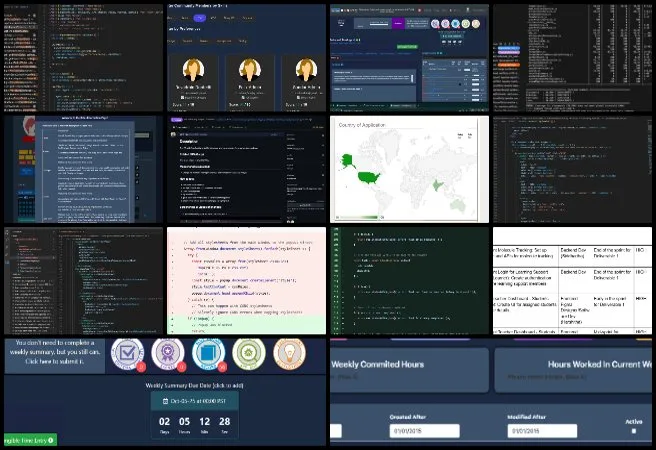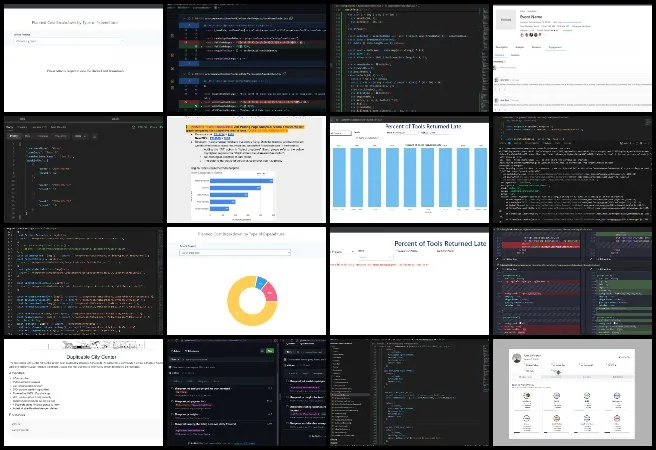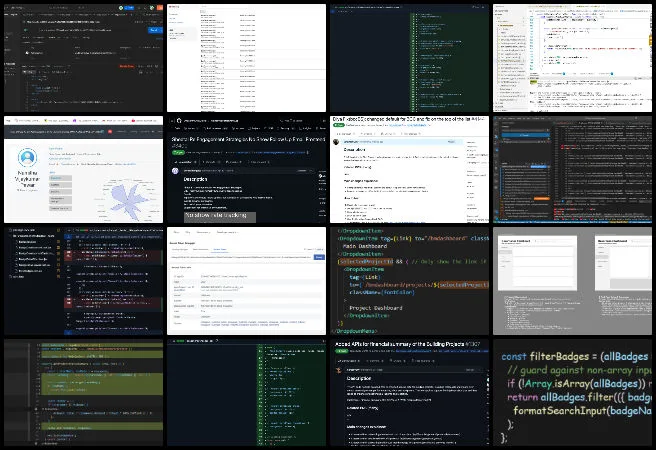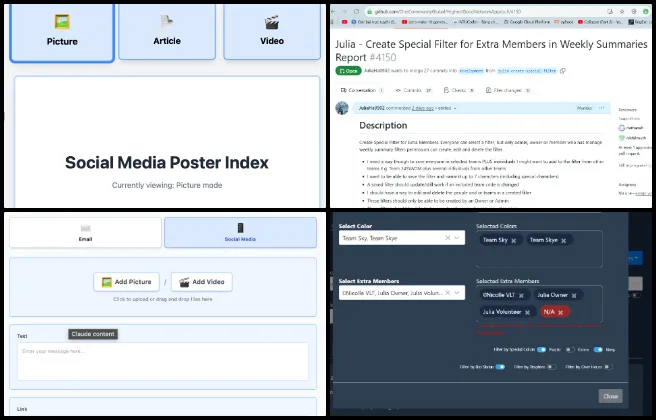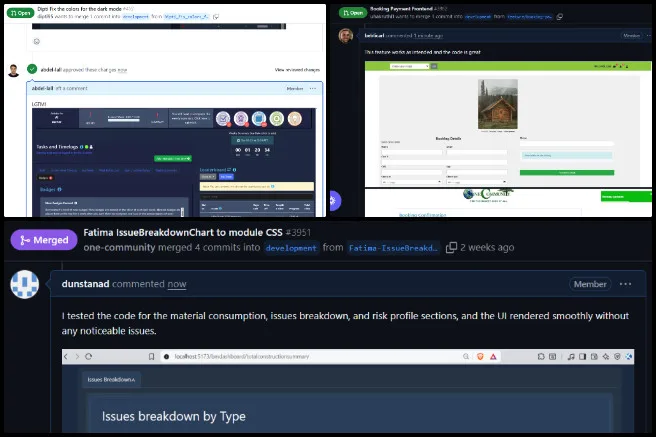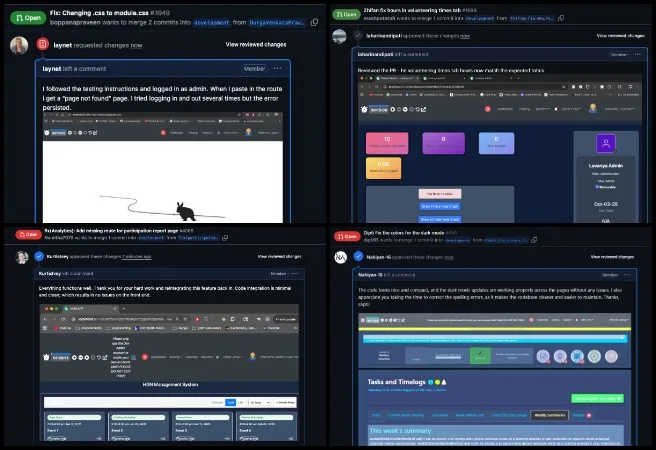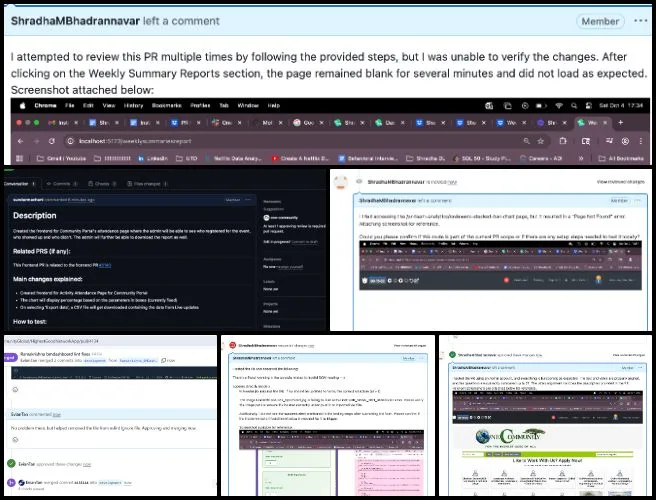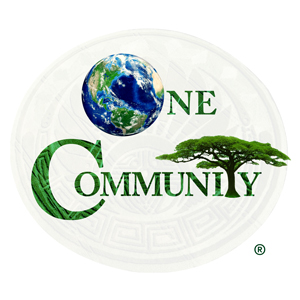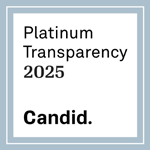Open Sourcing a Better World for Us All – One Community Weekly Progress Update #655
At One Community, we are open sourcing a better world for us all by developing and freely sharing integrated solutions for food, energy, housing, education, economics, social architecture, and more. Our all-volunteer team is creating freely shared models designed to be self-replicating, forming the foundation for a global collaboration of teacher/demonstration hubs. By open sourcing and free sharing the complete process, we are evolving sustainability, regenerating our planet, and working toward a world that works for everyone—always guided by our commitment to The Highest Good of All.
- Here’s our project overview
- Here’s our world-change methodology
- Here’s how this becomes self-replicating
- Here’s how we are open source and free-sharing all the do-it-yourself designs
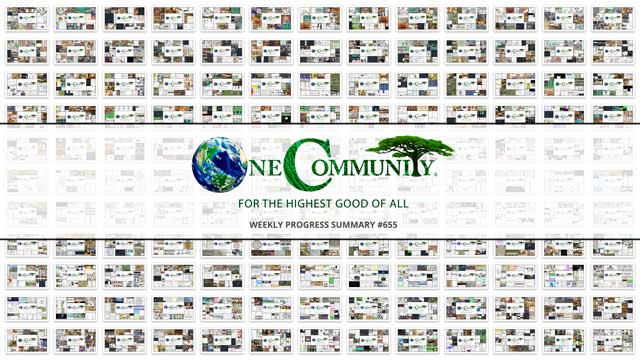
OUR MAIN OPEN SOURCE HUBS
Click on each icon to be taken to the corresponding Highest Good hub page.
One Community’s physical location will forward this movement as the first of many self-replicating teacher/demonstration communities, villages, and cities to be built around the world. This is the October 6, 2025 edition (#655) of our weekly progress update detailing our team’s development and accomplishments:
Open Sourcing a Better World for Us All
One Community Progress Update #655
DONATE | COLLABORATE | HELP WITH LARGE-SCALE FUNDING
CLICK HERE IF YOU’D LIKE TO RECEIVE AN EMAIL EACH WEEK WHEN WE RELEASE A NEW UPDATE
YOU CAN ALSO JOIN US THROUGH SOCIAL MEDIA
ONE COMMUNITY WEEKLY UPDATE DETAILS
HIGHEST GOOD HOUSING PROGRESS
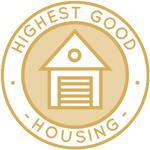 One Community is open sourcing a better world for us all through Highest Good housing that is artistic and beautiful, more affordable, more space efficient, lasts longer, DIY buildable, and constructed with healthy and sustainable materials:
One Community is open sourcing a better world for us all through Highest Good housing that is artistic and beautiful, more affordable, more space efficient, lasts longer, DIY buildable, and constructed with healthy and sustainable materials:
- Learn about: Our Upcoming Crowdfunding Campaign
- Learn about the different village models: 7 Sustainable Village Models
- Visit the open source portals for the first two: Earthbag Village OS Hub | Straw Bale Village OS Hub
This week, Ajay Adithiya Kumar Elancheliyan Tamilalagi (Mechanical Engineer) continued working on the ventilation system design for the Earthbag Village. He updated the version 2 HVAC system design for the vermiculture tank to incorporate a single fan positioned behind the filter, ensuring the fan remains protected from direct exposure to tank gases and allowing easier replacement of the fan and filter. He evaluated two power options —an electric fan and a wind turbine configuration—to facilitate continuous air and gas extraction from the tank. Ajay verified the airflow configuration and component placement for performance, and identified a bill of materials as necessary for documentation and assembly planning. One Community’s open source designs for open sourcing a better world for us all begin with the Earthbag Village, the first of seven planned villages providing housing. See below for some of the pictures related to this work.
Ananya Ranganatha (Architect and Project Engineer) completed the excavation drawing for the Tropical Atrium and made progress on the wall type diagram. She also started preparing the first-floor dimension plan identifying several issues in the existing drawings, including missing line joints and cluttered layers. She is cleaning up and organizing the drawings before continuing with additional detailing and layout development to maintain a clear foundation for further work. As the first of seven planned villages, the Earthbag Village provides the initial housing within One Community’s open source designs for open sourcing a better world for us all. View this week’s drawing updates in the collage below.
Baraka Minja (Civil and Environmental Engineer Pr. Eng.) continued working on the Vermiculture Toilet drawings, finalizing the CAD drawings by updating the structural layouts and sections to reflect the inclusion of support beams and columns. He added separate drawings for the column layout and beam layout to supplement the existing structural plans. He also inserted references for column and beam connection details. As the first of seven planned villages, the Earthbag Village provides the initial housing within One Community’s open source designs for open sourcing a better world for us all. The latest structural updates can be seen in this week’s compilation.
Derrell Brown (Plumbing Designer) continued working on the Earthbag Village final MEP report by updating plumbing and mechanical documentation related to design and calculation breakdowns. He reviewed the latest mechanical plans to refine the mechanical design process, finalized the load breakdown chart, and provided written details and images describing the associated equipment specifications. He also reviewed the latest plumbing plans to reflect similar updates for the water supply distribution, pipe sizing, and the development of a water heating sizing guide. One Community’s open source designs for open sourcing a better world for us all begin with the Earthbag Village, the first of seven planned villages providing housing. The corresponding MEP visuals are shared below.
Fangting Xu (Interior Design Intern) continued working on the ADA codes related to building connections to ensure accessibility compliance. She also worked on resolving AutoCAD and SketchUp account issues to restore software access. In addition, she coordinated the weekly meeting schedule, tracked project progress, and prepared summary reports to support communication and organization within the team. One Community’s open source designs for open sourcing a better world for us all begin with the Earthbag Village, the first of seven planned villages providing housing. See below for some of the pictures related to this work.
Karthik Pillai (Mechanical Engineer) continued work on the Vermiculture Toilet, focusing on completing the waste dumping mechanism project working on design verification and finite element analysis. He completed and verified the design with deflection remaining under 1 mm, which is considered safe based on online sources, and the maximum stress is well below the yield stress. In parallel, he also verified and confirmed the HVAC system for the vermiculture assembly. For the Earthbag Village 4 dome cluster roof design, Karthik continued work on the report. As the first of seven planned villages, the Earthbag Village provides the initial housing within One Community’s open source designs for open sourcing a better world for us all. The related visuals are shown below.
Malhar Solanki (Mechanical Engineer) continued working on the Earthbag Village, discussing the pending tasks and issues affecting progress on assigned work. He finalized the gas exhaust duct for the structure (collection bins), and began work on re-assigning and reviewing tasks initially assigned to Rahul. He took responsibility for HVAC systems and started listing the parts to be sourced in the BOM. The Earthbag Village, the first of seven planned villages, serves as the initial housing component within One Community’s open source framework for open sourcing a better world for us all. Review the latest HVAC updates in the images below.
Michaela Silva (Architect) continued working on details in the construction documents of the Earthbag Village, researching column connections and selected Simpson Strong-Tie CB88 for the 8×8 columns and Simpson Strong-Tie CB66 for the 6×6 columns. Based on product and manufacturer recommendations, she modeled drop footings below each column to provide 3 inches of concrete coverage on all sides of the connectors. She prepared detailed sections and plans for both column sizes to indicate the selected products and specified the required footing dimensions. The Earthbag Village, the first of seven planned villages, serves as the initial housing component within One Community’s open source framework for open sourcing a better world for us all. Check out the construction detail visuals below.
Rahul Kulkarni (Mechanical Engineer) continued work on the Vermiculture Toilet waste water channel CAD design preparing a preliminary CAD model for team discussion and refinement. He shared the updates with the team, and shifted efforts toward the finalization of the drawer modification. Progress continued on refining the drawer modifications, and feasibility checks were carried out in relation to ideas from other team members. He finalized the drawer modifications, and also established preliminary feasibility for the wastewater channel design. The Earthbag Village, the first of seven planned villages, serves as the initial housing component within One Community’s open source framework for open sourcing a better world for us all. Below are visuals highlighting this work.
Rishi Chakrapani (Mechanical Engineer) continued working on the Vermiculture Toilet, focusing on updating the design for the separator insertion platform and progressing the design of the waste filtration system, which included the sloped drainage tray, gravity-feeding system for liquid waste, liquid transportation gutter with outlet piping, and the enclosed filtration unit. He attended two team meetings, including the weekly meeting where design updates were provided and a separate meeting where the team decided to pivot the location of the filtration system. He completed preparations to allow for FEA and related calculations to be carried out in the following week. The Earthbag Village, the first of seven planned villages, serves as the initial housing component within One Community’s open source framework for open sourcing a better world for us all. See below for some of the pictures related to this work.
DUPLICABLE CITY CENTER PROGRESS
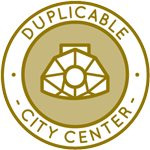 One Community is open sourcing a better world for us all through a Duplicable and Sustainable City Center that is LEED Platinum certified/Sustainable, can feed 200 people at a time, provide laundry for over 300 people, is beautiful, spacious, and saves resources, money, and space:
One Community is open sourcing a better world for us all through a Duplicable and Sustainable City Center that is LEED Platinum certified/Sustainable, can feed 200 people at a time, provide laundry for over 300 people, is beautiful, spacious, and saves resources, money, and space:
- Learn about this building and it’s function: Duplicable City Center Open Source Hub
This week, Anjana Reddy (Architectural Designer) continued work on the Duplicable City Center by rendering images of the landscape area. She focused on creating clear and detailed visuals for presentation and reviewed different project files for reference. While working on the landscape renders, she encountered a system crash that limited progress on one of the days. Anjana continued developing the walkaround video and rendered additional portions of the landscape area to enhance the project’s visual presentation. This open-source Duplicable City Center project contributes to developing open sourcing a better world for us all. Explore the landscape visuals in the image below.
Ariana Gutierrez (Industrial Designer) continued working on the Duplicable City Center presentation by correcting details based on guidelines established by Mr. Sabol to add professionalism. In addition, she began research on insulation installation, evaluating different types of materials, comparing their performance, and reviewing possible installation alternatives for future project applications. This open-source Duplicable City Center project is open sourcing a better world for us all. See the presentation updates and research highlights below.
Ayushman Dutta (Mechanical Engineer) continued working on the Duplicable City Center row 3 hub connector by performing FEA analysis, creating the material card, and importing the model into Ansys. He resolved meshing issues by cleaning the geometry and remeshing, made bolt connections on the model, and input the required elements for the analysis. Ayushman also redesigned the bolt connectors to improve the setup and redid the analysis to verify the results. He completed the row 3 hub connector analysis and compared the results with the row 2 hub connector to assess performance differences. This open-source Duplicable City Center project is open sourcing a better world for us all. Review the connector analysis visuals below for more details.
Nikhil Bharadwaj (Mechanical Engineer) continued working on the Duplicable City Center dome assembly by adding the row 3 hub connector and cutting beams to create the required clearances and fit. He worked with Koushik to plan the activities needed to complete the dome assembly and replace all the row 3 hub connectors. Nikhil received the latest assembly from Koushik and shared it with Srujan for storage on Dropbox. He also completed the row 3 assembly spreadsheet with guidance from the team, received the official handoff from Nupur, and obtained all the relevant project files. He then shared the latest assembly spreadsheet with the team for review and feedback. One Community’s Duplicable City Center is an example of open sourcing a better world for us all. The visuals below highlight his assembly progress this week.
Sandesh Kumawat (Mechanical Engineer) continued working on the City Center Natural Pool and Eco-spa Designs for the Duplicable City Center by completing the 3D meshing of the full spa assembly and preparing the model for contact setup across many interacting parts. He assigned material cards for each component (panel skins and foam, tub shell, outer frame/brackets, fasteners, and bearings) in consistent SI units. The mesh used a mix of tetra and hex elements: hex where prismatic blocks were feasible and tetra for complex features. Element sizes were applied by zone from ~5 mm on hinges, holes, fillets, and contact edges to ~200 mm on large, low-curvature faces, with gradual growth controls to maintain quality. Mesh checks for aspect ratio and skewness were adjusted where needed, and named selections were created to streamline contact definitions. Discover One Community’s open source Duplicable City Center for open sourcing a better world for us all. See the 3D meshing visuals below for a closer look.
Srujan Pandya (Mechanical Engineer) continued working on the Duplicable City Center load analysis by improving the snow load documentation. He embedded surface area calculations directly as text, supported with an introduction, explanations, and a consolidated image for clarity. Srujan scheduled a meeting with Dipak to review the wind and earthquake analysis model setup. He also organized and shared multiple file versions, including both Snow Load and Vertical Load files, with Jae for proper storage and referencing. The Duplicable City Center demonstrates open sourcing a better world for us all. Explore the refined load analysis work in the visuals below.
Vineela Reddy Pippera Badguna (Mechanical Engineer) continued contributing to the Duplicable City Center and Earthbag Village by updating the rainwater catchment spreadsheet to include storage performance. She calculated the minimum required storage tank capacity using an iterative trial-and-error method, added calculations for the supply-to-demand ratio and the minimum balanced storage capacity, cross-verified all the calculations, and revised the downspout placement to provide each floor with separate downspouts. This open source Duplicable City Center project is part of open sourcing a better world for us all. See the updated rainwater catchment data and design visuals below.
HIGHEST GOOD FOOD PROGRESS
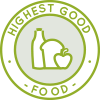 One Community is open sourcing a better world for us all through Highest Good food that is more diverse, more nutritious, locally grown and sustainable, and part of our open source botanical garden model to support and share bio-diversity:
One Community is open sourcing a better world for us all through Highest Good food that is more diverse, more nutritious, locally grown and sustainable, and part of our open source botanical garden model to support and share bio-diversity:
- Learn about the structures: Hoop House Hub | Aquapini & Walipini Open Source Hub
- See what we’ll be growing: Gardens & Hoop Houses | Large-scale Structures | Food Forest | TA
This week, the core team continued working on the Master Tools, Equipment, and Materials and Supplies List for the Large Garden and Botanical Garden. The team eliminated duplicate entries for the mallet and scissors, alphabetized the Large-scale Garden and chainsaw lists, and added the necessary fencing supplies to all documents that require fencing (LG, BG, CHICK, GT, RAB). The core team also removed several tractor attachments from the Tropical Atrium (TA) project and replaced the existing Tool Combo Kit with an updated version after the previous model was discontinued. The Highest Good Food initiative is a key component of One Community’s open source plans, focused on open sourcing a better world for us all, and exemplifies the organization’s commitment through innovative design and implementation. Below are some images showcasing this work.
Chelsea Mariah Stellmach (Project Manager) continued her work on the Transition Food Self-sufficiency Plan. She finalized the food bar report by adding information about how the food bars can be used during and between meals. Chelsea had a discussion with Shireen on ways to improve the new icons in order to align with the existing set. She also met with Jae to discuss a new project focused on exploring software options that could streamline inventory management and ordering processes for the future transition kitchen, drawing from recommendations in the Food Procurement and Storage Report. As part of this work, Chelsea is collecting feature data and screenshots to prepare materials for a potential proposal to develop new in-house software. As an essential aspect of One Community’s open source goals, the Highest Good Food initiative supports open sourcing a better world for us all. The following images provide a view of her contributions.
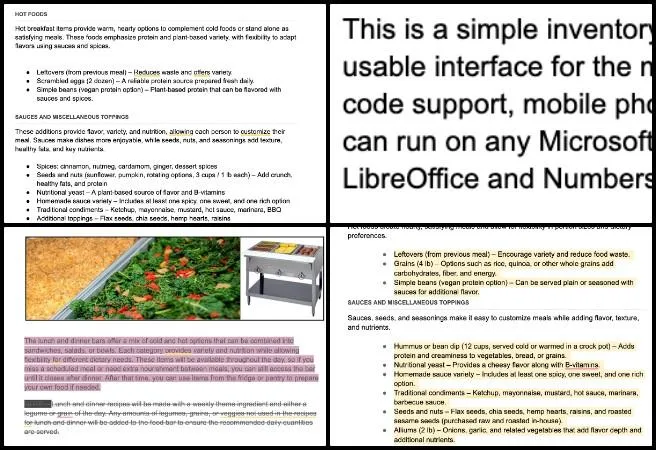
Dirgh Patel (Mechanical Engineer) continued assisting with the Climate Battery design updates. He worked on improving the greenhouse thermal simulation and ventilation documentation. He organized and clarified the different types of ventilation in Google Sheets with corresponding images and distinctions. Dirgh updated link addresses for all eight thermal simulation cases, including tables, to ensure proper referencing. He revised the heat design section by refining the area calculation, improving the transmissivity explanation, and adding a table showing total monthly solar heat gain. Dirgh clarified ventilation titles and created three tables in Google Sheets to calculate heat gain and ventilation requirements for maintaining internal temperatures of 30°C, 24°C, and 0°C. He added explanations for the stress–strain calculations in the report, detailing how pressure is measured and converted between different units. One Community’s open-source mission is powerfully reflected in the Highest Good Food initiative, which is focused on open sourcing a better world for us all. See the images below to review this week’s updates.
Gayatri Pandkar (Architect) continued contributing to the Highest Good Food initiative. She edited the Walipini 1 report, correcting the font type and size to meet the required format and adding a legend at the beginning along with a conclusion at the end. Gayatri then began work on the report for the Zenapini cloud forest structure, studying the rendered views to understand the layout and spatial organization. After reviewing the visuals, she started preparing the detailed report for the Zenapini structure, outlining its features and areas based on her observations. Gayatri also organized the images and diagrams to be included in the report, noted key spatial relationships and functional zones, and started compiling notes for the textual descriptions of each section. The Highest Good Food initiative is a key part of One Community’s open source platform, focused on sustainable and participatory development while open sourcing a better world for us all. Visual examples from her work are presented below.
Jay Nair (BIM Designer) continued on Aquapini and Walipini Planting and Harvesting documents. He worked on formatting the documents related to Walipini 1 lighting energy calculations. The focus was on aligning the structure and layout with the required standards for the project webpage. Adjustments included consistent use of headings, spacing, and data presentation to ensure clarity and ease of reference for future updates. The Highest Good Food initiative is a key part of One Community’s open source platform, focused on sustainable and participatory development while open sourcing a better world for us all. See below for pictures related to this work.
Keerthi Reddy Gavinolla (Software Developer) continued working on the Highest Good Food page. She updated the City Center Team Blog #654. Keerthi made changes to the Soil Amendment and Initial Off-grid Site Preparation page and started implementing them into the blog. She updated the formatting by adjusting headings, fixing spacing, and refining overall structure for consistency. Keerthi also completed her admin work for the week. Built on One Community’s open source foundation, the Highest Good Food initiative is dedicated to open sourcing a better world for us all, empowering communities through self-sustaining systems. Visual examples of her work are shown below.
Nitin Parate (Architect) continued contributing to the Highest Good Food initiative. His work centered on maintaining accuracy and consistency across the planting layout, spatial organization, and material specifications to align with the project’s sustainability and aesthetic goals. He requested confirmation from Jae regarding the final updated plan, plantation layout, and trench details to ensure all revisions were incorporated accurately. After receiving the confirmation and corresponding AutoCAD file, Nitin began the rendering process based on the finalized information to ensure the visuals accurately represent the updated design. The Highest Good Food initiative is a key part of One Community’s open source platform, promoting regenerative and participatory development while open sourcing a better world for us all. Images below showcase his contributions.
Pallavi Deshmukh (Software Engineer) continued working on the Aquapini and Walipini Planting and Harvesting pages. She created new content for blog 654 and collaborated with her teammates by reviewing input and integrating feedback to maintain a clear and consistent final version. Pallavi scheduled five interviews, three of which were completed for software development and administrative roles, and submitted the necessary details. After applying Jae’s recommendations, she integrated the Zenapini #2 content provided by Silin. Pallavi then updated the Walipini #2 page by incorporating Junyi Shi’s contributions, revising text, links, and images to align with current project requirements. In alignment with One Community’s open source objectives, the Highest Good Food project integrates the concept of open sourcing a better world for us all into a larger vision of regenerative living. Her contributions are highlighted in the collage below.
Shivangi Varma (Volunteer Architectural Designer And Planner) continued contributing to the Highest Good Food initiative. She refined the masterplan layout for the six structures of the Highest Good Food infrastructure in Illustrator, then continued to develop the textures and materials of the landscape and structures for the Photoshop render of the masterplan. Shivangi also updated the pathways and 2D plan shared by the architect volunteer. The Highest Good Food initiative plays a leading role in One Community’s open source platform by promoting sustainable and participatory development focused on open sourcing a better world for us all. Below are visuals highlighting this work.
HIGHEST GOOD ENERGY PROGRESS
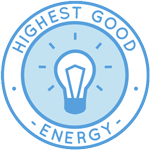 One Community is open sourcing a better world for us all through Highest Good energy that is more sustainable, resilient, supports self-sufficiency and includes solar, wind, hydro and more:
One Community is open sourcing a better world for us all through Highest Good energy that is more sustainable, resilient, supports self-sufficiency and includes solar, wind, hydro and more:
- Learn about the open source sustainable-energy foundations: Solar, Hydro, and Wind
- Explore our research into the most sustainable products and companies for saving water and energy: Insulation, Eco-laundry, Lightbulbs and Light Bulb Companies, Doors and Door Companies, Windows and Window Companies, Toilets, Faucets and Faucet Accessories, Urinals, and more.
This week, the core team contributed to the Highest Good Energy initiative. The team worked on the Grid-Tie vs Off-Grid report. The core team performed a read-through and made formatting edits, then created copies of the referenced spreadsheet to replace the charts and graphs with screenshot images showing the same data. The team also contacted Shravan to request the addition of a cost item for extending power lines to a property in the calculator tool. Afterward, the core team made a few basic adjustments to the copied version of the calculator to explore how the changes might function. The Highest Good Energy initiative plays a leading role in One Community’s open source platform by promoting sustainable and participatory development focused on open sourcing a better world for us all. Below are images related to this project.
Shravan Murlidharan (Electrical Engineer) continued supporting the Highest Good Energy initiative by focusing on two key areas related to the One Community Solar project. First, he reorganized and refined webpage content, optimizing tables and charts for clarity, logical flow, and consistency. This included multiple days of formatting adjustments, layout refinements, and alignment of charts with associated text to make the information easily navigable and understandable. Headings were refined, column formats aligned, and readability enhanced to maintain accuracy in data presentation. The second focus area involved analyzing the Energy Need spreadsheet by reviewing the data structure, identifying critical figures, and preparing them for alignment with broader project goals. Early work ensured energy requirements were clearly represented and linked to practical outcomes. The transition from webpage refinements to spreadsheet analysis marked a shift from presentation-focused tasks to data-oriented work that will inform upcoming project steps. One Community’s open source mission is powerfully reflected in the Highest Good Energy initiative, which supports open sourcing a better world for us all as a model for global impact. The following visuals illustrate Shravan’s contributions.
HIGHEST GOOD EDUCATION PROGRESS
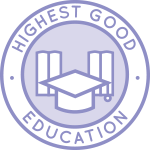 One Community is open sourcing a better world for us all through Highest Good education that is for all ages, applicable in any environment, adaptable to individual needs, far exceeds traditional education standards, and more fun for both the teachers and the students. This component of One Community is about 95% complete with only the Open Source School Licensing and Ultimate Classroom construction and assembly details remaining to be finished. With over 8 years of work invested in the process, the sections below are all complete until we move onto the property and continue the development and open sourcing process with teachers and students – a development process that is built directly into the structure of the education program and everything else we’re creating too:
One Community is open sourcing a better world for us all through Highest Good education that is for all ages, applicable in any environment, adaptable to individual needs, far exceeds traditional education standards, and more fun for both the teachers and the students. This component of One Community is about 95% complete with only the Open Source School Licensing and Ultimate Classroom construction and assembly details remaining to be finished. With over 8 years of work invested in the process, the sections below are all complete until we move onto the property and continue the development and open sourcing process with teachers and students – a development process that is built directly into the structure of the education program and everything else we’re creating too:
- Program Overview: Education Open Source Hub
- How the components work together in designing human orchestrated eco-abundance: How to use the Education for Life Program
- Lesson Plans for Life – Lesson Plans How-to
- Foundations of Outstanding Leaders, Teachers, and Communicators
- Curriculum for Life
- Teaching Strategies for Life
- Learning Tools and Toys for Life
- Evaluation and Evolution
This week, Anuneet Kaur (Administrator) continued contributing to the Highest Good Education software platform by creating Figma design elements and refining the visual layout, supporting One Community’s dedication to open sourcing a better world for us all. She updated the Redo Assignments UI and Project Manager Dashboard in Figma, incorporating feedback from Harshitha to refine the Resource Requests and Resource Utilization sections for usability and design consistency. Anuneet also researched sustainable flooring, reviewed scholarly articles, and compiled relevant statistics for the graphic process. She ensured all members were included in the live blog task and completed drafting content and selecting images for the Highest Good Education Program Licensing and Accreditation webpage. Additionally, she reviewed Yulin’s sustainable research infographic and provided feedback. Her administrative contributions included editing summaries and collages for the Highest Good Society team, Highest Good Education team, and the core team, while reviewing fellow admins’ submissions for accuracy and completeness. The One Community model of open sourcing a better world for us all, exemplified by sustainably built classrooms like these, fosters lasting global impact. Her recent contributions are featured in the collage below.
Harshitha Rayapati (Program Manager) continued advancing the Highest Good Education platform by detailing deliverables, developing Figma designs, and expanding the visual layout of the student dashboard. She collaborated with developers Prem, Neeraj, and Taariq to clarify tasks in the HGN document and assigned Figma tasks to Srushti. Harshitha worked to understand website requirements and create the initial software outline for HGN Phase 5, while supporting developers on Phase 4 by resolving questions and issues. She reviewed Phase 5 governance tool requirements, scoped Figma design tasks, addressed Jae’s color adjustment requests, followed up with developers, and removed blockers to support progress. Additionally, she compiled the weekly blog update, reviewed the Housing team’s progress, edited the blog page, and created a collage summarizing the week’s efforts. The One Community model of open sourcing a better world for us all, exemplified by sustainably built classrooms like these, advances meaningful global change. The images below provide a visual summary of her contributions.
Ravi Kumar Sripathi (Software Engineer) continued developing the Highest Good Education software platform by creating Figma designs and refining the Build Lesson Plan module, which guides students in transforming their saved interests into weekly learning plans. He also created wireframes for the “Create Announcements” feature in Figma, allowing educators to compose and share non-task-specific communications. The full-screen composer includes fields for the announcement title, message body, and optional attachments, enabling content formatting, link inclusion, and file uploads. Users can select target audiences such as all students, specific groups, learning support teams, or particular classes, with searchable selectors and dynamic student counters. Delivery options include scheduling, expiration dates, and email notifications. Additional features include announcement history, dashboards to view published, scheduled, or draft items, engagement indicators, reusable templates, pinned announcements, and search/filter tools for managing past messages. These updates enhance functionality and user experience, strengthening the One Community model of open sourcing a better world for us all. The visuals below highlight Ravi’s work from this week.
HIGHEST GOOD SOCIETY PROGRESS
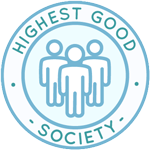 One Community is open sourcing a better world for us all through a Highest Good society approach to living that is founded on fulfilled living, the study of meeting human needs, Community, and making a difference in the world:
One Community is open sourcing a better world for us all through a Highest Good society approach to living that is founded on fulfilled living, the study of meeting human needs, Community, and making a difference in the world:
- Read the Highest Good society overview: Highest Good Society
- Learn about the model for fulfilled living and sharing: A Day in the Life
- Learn about the 4 economic models: RBE | For-profit | Non-profit | Entrepreneurship
- Learn about our open source community collaboration and management software: The Highest Good Network
This week, the core team completed over 55 hours managing volunteer work reviews, handling emails, overseeing social media accounts, supporting web development, identifying new bugs, integrating bug fixes for the Highest Good Network software, and interviewing and onboarding new volunteer team members. They also produced and integrated the video above, highlighting how open sourcing a better world for us all serves as the foundation of One Community’s broader mission. The following images showcase highlights of this work.
Govind Sajithkumar (Project Manager) continued focusing on analytics and content management for Meta’s Facebook and Instagram channels. He managed the weekly social media content for Meta platforms by preparing, scheduling, and uploading a regular batch of posts. He updated the Open Source spreadsheet with all new content information, including post descriptions and publishing timestamps. Govind also performed an update of the social media analytics spreadsheet with the latest performance metrics. Additionally, he completed PR Review Team Management by modifying a WordPress site with the team’s weekly summary and collage, filling the PR Review Team Table, and updating the Highest Good Network PR spreadsheet. He submitted his admin feedback table, which further supports One Community’s mission of open sourcing a better world for us all. The images below highlight key aspects of his contributions.
Jaiwanth Reddy Adavalli (Project Manager) continued developing the Job Applicants page and key components of the Highest Good Network Phase 2 and Phase 4 dashboards, including the PR Team analytics section. He worked on the Application Page by editing the design and action items for several components. He tracked updates in software team management documents to support task management. Jaiwanth also tested multiple pull requests in the Highest Good Network software. As a member of the pull request review team, he reviewed submissions from the volunteer team assigned to him. This work supports One Community’s commitment to open sourcing a better world for us all. The images below provide examples of his recent work.
Rajrajeshwari Gangadhar Sangolli (Data Analyst) continued working on Google Ads management and strategy evolution. She analyzed Google Ads performance, updated goals, budgets, and bidding strategies, and optimized campaigns by revising headlines and descriptions. She applied Google recommendations, cleaned and processed one year of data, and built Tableau dashboards to track impressions, reach, conversions, and costs. Rajrajeshwari added a new chart to display ad strength and reviewed multiple PRs, testing them across admin, manager, test, and volunteer accounts while logging issues and feedback. She created new data points for Building 3 to validate chart logic and webpage functionality. She reviewed Phase 2 tasks, verified one functional PR, coordinated with Sudarshan on data uploads, and followed up with Sara on missing components and PDF fixes. She also completed steps 1–4 for eleven volunteers, summarized their work with keywords and collages for the weekly website update. This project supports One Community’s commitment to open sourcing a better world for us all. Visual highlights of her work are provided below.
Yagna Reddy Badvel (Data Analyst and Team Administrator) continued working on the Summary Dashboards and Weekly Report page on the Highest Good Network. He focused on validating multiple dashboard components within the Highest Good Network software. He created five test users along with a test project and assigned corresponding tasks to verify data flow through the summaries and task-completion metrics. Yagna observed that while the Volunteers Completed Assigned Hours component updated correctly from 25 to 27, both the Total Summaries Submitted and Tasks Completed metrics remained static, indicating additional logic issues. He documented each finding with screenshots, updated the issue tracker, and prepared notes for upcoming pull requests. Earlier in the week, he also completed administrative updates, including feedback integration, correcting the PDF flagged by Sara, and confirming that prior dashboard validations remained consistent. This work supports One Community’s commitment to open sourcing a better world for us all. The following images display his contributions from this week.
ADMINISTRATION TEAM
The Administration Team’s summary, which covers their work on the Highest Good Network, was managed by Prudhvi Marpina (Data Analyst) and includes Ashutosh Mishra (Software Engineer), Divanshu Bakshi (Team Admin), Georgina George (Business Intelligence Analyst), Indra Anuraag Gade (Software Engineer and Team Administrator), Keerthana Chitturi (System Administrator), Mridul Bhushan (Volunteer Project Strategy Analyst and Team Administrator), Neeharika Kamireddy (Data Analyst), Olawunmi “Ola” Ijisesan (Administrative and Management Support), Olimpia Borgohain (Data Analyst and Team Administrator), Rachna Malav (Data Analyst), Rajeshwari Bhirud (Administrator), Rishi Sundara (Quality Control Engineer and Team Administrator), Rishitha Adepu (Administrator), Sai Suraj Matta Veera Venkata (Business Data Analyst), Samhitha Are (Administrator), and Sudarshan Raju Chintalapati Venkata (Data Analyst). The team provides essential support to the Highest Good Network, a tool designed to manage and objectively measure progress while building open-source solutions for global sustainability. Through administrative support, documentation, testing, training, recruiting, analytics, and content management, the team directly contributes to open sourcing a better world for us all and to One Community’s mission of building a replicable model for a sustainable future.
This week, Ashutosh tested frontend chatbot components with four agentic functions, verified the email capability via a dummy SMTP setup, retrieved and displayed textual documents on the frontend, performed website information searches, and handled basic query responses. This work contributes to One Community’s commitment to open sourcing a better world for us all. He created eight Google documents, added them to a Pinecone vector database, tested retrieval accuracy for proper embedding integration, and implemented a custom parser to improve structured table handling. Divanshu focused on testing and validating HGN pull requests, coordinating task assignments, tracking results in a spreadsheet, and analyzing Mastodon platform strategies while managing documentation and blogs. Georgina worked on the master dashboard by collecting and organizing data, calculating key performance metrics, integrating them into the main dashboard, verifying accuracy, and preparing it for team review. This effort reflects One Community’s focus on open sourcing a better world for us all. Indra prepared Weekly Progress Blog 654 for the Code Crafters Team, managed X/Twitter analytics by scheduling posts, logging engagement metrics, fixing dashboard visualization errors, and restructuring dashboards into all-time and weekly views with dynamic updates and documentation. Keerthana reviewed team submissions, updated Step 2 and Step 4 tracking documents, prepared the weekly blog, and contributed to Phase 3 testing with validation and documentation. This project supports One Community’s dedication to open sourcing a better world for us all. Mridul refined individual summaries for formatting and compliance, compiled the team summary for the WordPress blog, followed up with members for corrections, organized project folders and weekly images, optimized the collage, generated alt text and SEO lines, updated the HGN Questionnaire, refined blog phrasing, and analyzed HGN Phase 2 PRs 3565, 3488, 3678, and 3252. Neeharika reviewed software management documents and PR dashboards, followed up on task progress, tested PRs in development, and completed administrative duties. This progress highlights One Community’s mission of open sourcing a better world for us all.
Ola maintained workflow for the administrative team by organizing files, clearing content tables, supervising PR managers for accuracy, monitoring HGN spreadsheets, and submitting the weekly report with images. Olimpia handled senior admin duties by monitoring volunteer progress, resolving comments, identifying members needing warnings, informing Jae, and analyzing LinkedIn analytics with graphs and report edits. Rachna responded to a volunteer inquiry email, forwarded it to Jae for action, reviewed older communications, and continued her SEO work. This progress highlights One Community’s mission of open sourcing a better world for us all. Rajeshwari continued as Administrator for Blog 654, reviewing summaries, adding comments and feedback, updating Binary Brigade content, editing the WordPress private blog with summaries and collage, completing the HGN questionnaire, updating the feedback tracker, uploading the corrected PDF, and testing UI-related issues in the development environment. Rishi tested PRs 3988, 3947, and 4136, informed Jae about PRs ready for merging, followed up on Slack, merged individual blogs into Blog 654, completed SEO tasks, and labeled urgent PRs as High Priority – Please Review First. This work is part of One Community’s goal of open sourcing a better world for us all. Rishitha conducted six interviews, supported blog review with Mridul, updated bios, followed up on missing details, uploaded content on Threads, and reviewed weekend tasks for the organization. Sai Suraj advanced the Social Media Analytics Master Dashboard, finalized the Index of Data Visualizations, researched Facebook and Instagram analytics, fixed dashboard issues, completed channel transitions, assumed posting and analytics duties, provided feedback, updated the webpage with SEO adjustments, organized images, created a collage, and finalized the page for Jae’s review. This development strengthens One Community’s vision of open sourcing a better world for us all. Samhitha reviewed blogs by Divanshu and Sudarshan, tested HGN Phase 3 functionality, documented issues, refined the testing process, and updated spreadsheets for clarity and resolution tracking. Sudarshan managed Alpha Software Team blogs with content review, SEO updates, and collages, reviewed multiple Phase 2 PRs, tested UX/UI in the dev environment, validated dashboards, provided feedback, updated task lists, and scheduled Zoom meetings for task coordination and PR discussions. To learn more about how this work contributes to open sourcing a better world for us all, visit the Highest Good Society and Highest Good Network pages. The images below provide a visual overview of the team’s contributions.
GRAPHIC DESIGN TEAM
The Graphic Design Team’s summary includes Qinyi Liu (Graphic Designer) and Yulin Li (Graphic Designer), who focused this week on creating graphic designs that support open sourcing a better world for us all.
This week, Qinyi created and updated bio images and announcements, edited characters using ChatGPT, and integrated all materials into the website as part of open sourcing a better world for us all. Yulin revised one infographic and three volunteer announcements, posted the Highest Good Network collaboration update, managed assets via Dropbox, and participated in review discussions as part of open sourcing a better world for us all. Their combined efforts highlight open sourcing a better world for us all. See the Highest Good Society pages and the collage below for examples of their work.
HIGHEST GOOD NETWORK PROGRESS
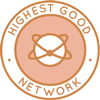 One Community is open sourcing a better world for us all through open source Highest Good Network® software that is a web-based application for collaboration, time tracking, and objective data collection. The purpose of the Highest Good Network is to provide software for internal operations and external cooperation. It is being designed for global use in support of the different countries and communities replicating the One Community sustainable village models and related components.
One Community is open sourcing a better world for us all through open source Highest Good Network® software that is a web-based application for collaboration, time tracking, and objective data collection. The purpose of the Highest Good Network is to provide software for internal operations and external cooperation. It is being designed for global use in support of the different countries and communities replicating the One Community sustainable village models and related components.
- Learn about our open source community collaboration and management software: The Highest Good Network
This week, the core team continued working on the Highest Good Network software by completing and confirming several pull request fixes. They performed HGN PRs testing and confirmed 25 fixed PRs. The following PRs were not fixed: created blue square assigned functionality #3376, fix weekly summary reports team code changes on refresh #3688+1509, Frontend for Community Portal – Attendance Page #3140, make pop-out timer look like expanded-view timer #3707, and PR Review Dash – Top 20 Most Popular PRs #3746. Additionally, they reviewed assigned badges for “Tester One” and logged seven hours for this week to test the “New Max” badge, documenting the results in the corresponding record. See the Highest Good Society and Highest Good Network pages for more on how this work strengthens open sourcing a better world for us all.
ALPHA SOFTWARE DEVELOPMENT TEAM
The summary for the Alpha Team was managed by Lin Khant Htel (Frontend Software Developer), the team includes Carlos Martinez (Software Developer), Nikita Kolla (Full Stack Developer), Nick Hujarski (Software Engineer), and Meron Qelati (Software Engineer). The Highest Good Network software is a key part of open sourcing a better world for us all, helping track and measure progress toward creating a sustainable world. The software supports social architecture, construction, production, and maintenance processes that contribute to the open source project and resilient ecosystems. Designed to be portable and scalable, the Highest Good Network software is well suited for off-grid and sustainable living communities. This project reflects One Community’s open source commitment to advancing the idea of open sourcing a better world for us all.
This week, Lin managed the Alpha Team summary, reviewed PR #1763, tested the code locally, and confirmed that seven of eight test cases passed as expected. She also reviewed and checked weekly summaries, photos, and videos submitted by team members while performing management responsibilities. This development strengthens One Community’s vision of open sourcing a better world for us all. Carlos worked on processing applicant data and displaying it in a donut chart with filter options for role and start date range, focusing on backend logic to ensure database queries functioned correctly with or without parameters. He verified that the query structure handled different filter combinations and returned consistent results, adding additional documents to the database to test various scenarios and confirm data accuracy. This work contributes to One Community’s commitment to open sourcing a better world for us all. Nikita continued work on the task “Total Org Summary: Fix Stats Accuracy (NEW),” investigating discrepancies between statistics displayed on the Total Org Summary page and the Reports page, with special attention to the hours worked metric and related documentation.
Meron reviewed PR #4135, examined the list of current bug-fixing tasks, and found that all Phase 1 bugs were already assigned. To continue contributing, he tested the development application to identify issues and reported an accessibility problem on the login page related to low text contrast on the “Sign In” button, documenting it with screenshots and requesting edit access to the shared document for progress tracking. This effort builds on One Community’s aim of open sourcing a better world for us all. Nick worked on the ticket “Total Org Summary: Fix Volunteer Roles & Team Dynamics Blue Squares Pie Chart Stats,” setting up Loom for screen recording, creating a new branch, reviewing and testing existing code, and identifying the backend API source of data. He resolved MongoDB backend issues, verified frontend chart functionality, and used Postman to analyze API aggregation routes. More details on how this work supports the idea of open sourcing a better world for us all can be found on the Highest Good Society and Highest Good Network pages for more on how this contributed to the idea of open sourcing a better world for us all. See the collage below to view the team’s work.
BINARY BRIGADE SOFTWARE DEVELOPMENT TEAM
The Binary Brigade Team’s summary, presenting their work on the Highest Good Network software, was managed by Nikhil Routh (Software Engineer) and included Abhishek Srikanth (Software Engineer), Deep Shah (Software Engineer), Kanishk Agarwal (Software Engineer), Ramsundar Konety Govindarajan (Software Engineer), Harsha Rudhraraju (Software Engineer), Sourabh Bagde (Software Developer), Srushti Patel (Software Developer), Manvi Kishore (Software Engineer), Taariq Mansurie (Full-Stack Developer), Xinyi Zhou (Developer), Zoha Khan (Software Engineer), Amalesh Arivanan (Software Engineer) and Rohit Mamidi (Software Engineer). The Highest Good Network software is our tool for managing and objectively measuring progress, ensuring that all contributions are tracked, aligned with our mission, and open sourcing a better world for us all.
This week, Amalesh fixed an issue with incorrect team codes displayed on the Weekly Summaries Reports page, ensuring that when a user is reactivated following a team code change, the updated code appears consistently across both the Profile and Reports pages. He verified data accuracy, implemented code updates, tested the changes, documented the process with screenshots and videos, and uploaded them following the required naming conventions. This effort supports One Community’s aim of open sourcing a better world for us all. Abhishek resolved a text size and placement issue on the Total Construction Summary page to maintain readability across screen sizes and reviewed multiple pull requests (PRs 4133, 4136, 4139, 4141, 4145, and 4147), evaluating functionality, interface changes, and code formatting. Deep addressed frontend feedback and updated backend logic for duplicate team member calculations, analyzed database queries to distinguish “In Team” and “Not In Team” members, implemented and tested the fix, and created pull requests for both frontend and backend changes. Harsha worked on the “Cleanup and Completion for Application Page/Function” task, reviewing and verifying PRs 4010 and 1704, 3842 and 1629, 4026, 4158, 4014, 4033, 4012, 3884, and 1636, confirming functionality, verifying dark mode consistency and responsiveness, and coordinating with developers on unresolved issues and merge conflicts. This work embodies One Community’s principles of open sourcing a better world for us all.
Kanishk continued Phase 3 of the Event Popularity Analytics landing page, implementing a pie chart, bar graph, summary cards, navigation links, and trend visualizations, resolving dropdown menu bugs, testing features, and submitting the final pull request for the phase. Manvi reviewed multiple pull requests (HGNRest PR 1751, HighestGoodNetworkApp PRs 4156 and 4157, and backend PR 1772) and worked on debugging Pinterest auto-posting, addressing authentication and scheduling errors. This task is part of One Community’s broader plan for open sourcing a better world for us all. Nikhil migrated legacy CSS files to CSS Modules across the Community Portal, BM Dashboard, and Teams components, updated imports and className references, resolved issues in PR 3370, tracked progress on CSS migration, reviewed PR 3768, and managed task delegation across the team. Ram implemented permission controls for the plus/minus (“+/–”) button on profile pages, expanding access management to enable owners and admins to assign specific permissions, updated related service endpoints, integrated the feature into the interface, and raised a clarification on user access paths. This progress aligns with One Community’s purpose of open sourcing a better world for us all. Rohit expanded the badge validation framework, adding modular and parameterized functions, integrating workflows into automation pipelines, testing across staging environments, and documenting findings for optimization. This work strengthens One Community’s framework for open sourcing a better world for us all.
Sourabh completed the Slashdot auto-poster feature, added a new Announcements tab, resolved conflicts, refined UI behavior for long tags, tested validation and dark mode consistency, and prepared to continue Figma mockups. Srushti built the dashboard and hour-logging screens, added progress bars and status tags, and began work on the Announcements screens. Taariq focused on the Phase 4 Assign Lesson Plan UI, developed layout components, aligned with Figma designs, addressed Node compatibility issues, and improved build stability while reviewing related documentation. Xinyi added export and filter functionality to several Total Org Summary components and reviewed peer PRs. Zoha began work on the Truth Social auto-poster feature, verified local functionality, reviewed frontend and CSS changes, and outlined steps to build the new component and routing. See the Highest Good Society and Highest Good Network pages for more about how this relates to open sourcing a better world for us all. The collage below shows images of their work.
BLUE STEEL SOFTWARE DEVELOPMENT TEAM
The Blue Steel Software Team, working on the Highest Good Network software, was managed by Divanshu Bakshi (Product Manager) and includes Linh Huynh (Software Engineer), Felix Huang (Software Engineer), Humemah Khalid (Software Engineer/Backend Developer), and Sheetal Mangate (Software Engineer). Felix focused on resolving issues related to WBS categories not assigning correctly on refreshed WBS pages within the HGN software development project, supporting the broader mission of open sourcing a better world for us all. Between September 30 and October 4, he revised the business logic multiple times to fix category persistence issues, ensuring that updates to project categories were accurately saved and consistently reflected across related task categories.
Linh completed three unit testing tasks involving the taskEditSuggestionController, taskNotificationController, and timeEntryController. Her work included analyzing controller logic, identifying workflows, and implementing extensive test coverage for data validation, error handling, transaction management, permission checks, caching behavior, and reporting. This work contributes to One Community’s commitment to open sourcing a better world for us all. She also refactored each controller for proper test structure, applied mocking for database and permission models, and refined the test suites to align with ESLint standards, achieving full pass rates across all test cases. Humemah worked on backend API updates related to the “Set Final Day” permission, reviewing the user profile schema to locate where permissions are stored and analyzing how validation should be applied within the API. She also reviewed the existing logic to understand how permissions integrate with user roles and influence access control mechanisms. Sheetal worked on the Reddit auto-poster project by implementing a file upload feature using Multer middleware in Node.js. She created a backend API endpoint for receiving form data, updated the frontend React code to handle FormData uploads, and configured the backend for file storage. Additionally, she began implementing task scheduling functionality to automate the posting process for uploaded files as part of the ongoing effort toward open sourcing a better world for us all. The collage below shows images of their work.
CODE CRAFTERS SOFTWARE DEVELOPMENT TEAM
The Code Crafters Team, covering their work on the Highest Good Network software, was managed by Indra Anuraag Gade (Software Engineer and Team Administrator) and includes Ajay Naidu (Software Engineer), Akshith Kumar Reddy Balappagari Gnaneswara (Software Engineer – Full Stack), Benitha Sri Panchagiri (Software Engineer), Chaitanya Swaroop Kumar Allu (Software Engineer), Hemanth Chimakurthi, Juhitha Reddy Penumalli (Software Engineer), Rahul Bagul (Software Engineer), Sphurthy Satish (Software Engineer), and Vivek Chandra (Software Engineer). The Highest Good Network software is how we’ll manage and objectively measure our process for establishing abundant community systems through our social architecture, construction, production, and maintenance efforts, while supporting widespread and lasting eco-lifestyle access. This initiative reflects One Community’s commitment to open sourcing a better world for us all, creating clear pathways to a more regenerative and thriving future.
This week, Ajay investigated a dashboard issue where navigating between the dashboard and tasks caused the view to break. He created a new branch to isolate changes and updated TeamMemberTask.jsx and TeamMemberTask.css by refactoring styles, stabilizing layouts, and correcting rendering and overflow problems while ensuring that task names with long titles displayed properly. This effort reflects One Community’s focus on open sourcing a better world for us all. Akshith focused on testing pull requests (PRs 1751, 3683, 1482, 4122, 4125, 1757, 4135, 4138, and 1759) by verifying endpoints, checking frontend updates, and leaving comments with potential fixes. He also began developing the lesson plan database by creating the student tasks table and related database structures. This project supports One Community’s dedication to open sourcing a better world for us all. Benitha resolved compilation errors caused by mismatched imports across files following recent changes to the folder structure. Chaitanya implemented a newsletter template editor system for weekly progress updates, building a React-based interface with rich text editing, preview, and validation; integrating the Google Cloud API for email delivery; and creating backend services for batch sending, image handling, access control, and subscription list management, while implementing logging and error handling. This work is part of One Community’s goal of open sourcing a better world for us all.
Hemanth validated multiple pull requests to ensure functionality, UI consistency, and theme compatibility, reviewing updates such as export buttons, graphs, charts, loaders, and CSS fixes across dashboard modules. Juhitha completed the Financials KPIs integration for the Phase 2 Summary Dashboard by finalizing pull requests, verifying API connections, fixing CSS issues, and testing in both light and dark modes. She also began work on the Imgur auto-poster by developing the UI, integrating the API for image uploads, and troubleshooting. This development strengthens One Community’s vision of open sourcing a better world for us all. Rahul advanced the integration of SonarQube with the HGN/One Community project by outlining setup steps, analyzing impacts, preparing plans for pull request and VS Code integrations, and producing documentation and a video tutorial to guide configuration. Sphurthy worked on Phase 4 of the Assign Lesson Plan feature, developing the backend API and logic for assigning tasks only when prerequisites are met, creating StudentTasks records with deadlines, updating StudentAtoms, and implementing validation utilities while continuing code development despite pending database testing. This step supports One Community’s path toward open sourcing a better world for us all. Vivek coordinated code reviews for the education portal project, verified and approved one pull request, and communicated delays on another related to the database. He also focused on writing and refining a seeder script to initialize collections by installing MongoDB locally, configuring the environment, and ensuring schema alignment. These contributions strengthen One Community’s open source mission and commitment to open sourcing a better world for us all. See below for pictures of the team’s work.
DEV DYNASTY SOFTWARE DEVELOPMENT TEAM
The Dev Dynasty Team’s summary, covering their work on the Highest Good Network software, was managed by Zhifan Jia (Software Engineer), and includes Adithya Cherukuri (Volunteer Software Engineer), Aditya Gambhir (Software Engineer), Deekshith Kumar Singirikonda (Developer), Manvitha Yeeli (Software Engineer), Mohan Satya Ram Sara (Software Engineer), Nahiyan Ahmed (Full-Stack Software Developer), Neeraj Kondaveeti (Software Engineer), Prem Vora (Software Developer), Shraddha Shahari (Software Engineer), and Vamsidhar Panithi (Software Engineer). The Highest Good Network software is how we’ll manage and objectively measure our processes for open sourcing a better world for us all through our social architecture, construction, production, and maintenance processes.
This week, Nahiyan reviewed PR 4161, ensuring consistent dark mode updates and corrected spelling issues across the codebase without affecting layout or functionality. Adithya verified component placement on the Social and Recreational Management page, completed Phase 3, Deliverable 3 reviews, and developed a donut chart in the Summary Dashboard with tooltips, filter logic, and layout refinements. Aditya implemented mentor tracking in volunteer statistics, fixed double counting in the Total Org Summary, rewrote volunteer hour calculations using weekly averages, reviewed frontend changes, and documented backend issues for follow-up. This effort supports One Community’s aim of open sourcing a better world for us all. Deekshith strengthened backend controllers for badges, forms, and wishlists by adding validation, ownership checks, and structured error handling to enforce secure, user-specific access. Manvitha resolved a front-end InvalidTokenError, fixed a text update issue on the Collaboration page, and implemented the User State feature with colored status tags, caching, and scoped data fetching, and submitted updates in PRs 1772 and 4157.
Mohan enhanced the Blue Square scheduling system by adding edit and save functionality, overlap validation, alerts, and user role restrictions, ensuring consistent behavior across all views. This work embodies One Community’s principles of open sourcing a better world for us all. Neeraj developed the student-facing Tasks dashboard with task cards, filters, grouping, progress tracking, due date badges, and a responsive layout aligned with Figma designs. Prem began Phase 4 backend development for student evaluation viewing, creating router, service, and controller structures, and coordinating with team members on database design and API planning. Shraddha advanced work on editable email functionality, resolved lint issues, fixed merge conflicts, and validated tests for PRs 2210, and 2266. This progress aligns with One Community’s purpose of open sourcing a better world for us all. Vamsidhar focused on the Re-Engagement Strategies feature, resolving backend and frontend merge conflicts, updating endpoints to align with REST best practices, upgrading Node.js and restoring pre-commit functionality for stable builds. Zhifan completed backend tasks to display student assignments by injecting test data, creating scripts, documenting PRs, tracing data flow to identify and resolve MongoDB aggregation issues, and merging fixes across multiple analytics-related tasks. See the Highest Good Society and Highest Good Network pages for more on how this relates to our mission of open sourcing a better world for us all. Explore some of the team’s work in the collage below.
EXPRESSERS SOFTWARE DEVELOPMENT TEAM
The Expressers Team’s summary, which covers their work on the Highest Good Network, was managed by Rahul Trivedi (Software Engineer) and includes Meenashi Jeyanthinatha (Full-Stack Developer), and Tanmay Arora (Software Engineer). This contribution supports One Community’s goal of open sourcing a better world for us all.
This week, Meenashi updated the Collaboration Ads page using actions and reducers to enable document saving, added filtering of positions based on the selected category, and implemented validation for the imageURL and jobDetailsLink fields with links stored in Dropbox. The location field was set to default to “Remote,” and the backend getPositions endpoint was updated to accept an optional category parameter. This progress aligns with One Community’s purpose of open sourcing a better world for us all. Additional updates included adding document-extension checking for the jobDetailsLink, refining input labels, and modifying the applyLink field to use values from jobForms. An issue with the /api/jobforms/all endpoint returning a 401 Unauthorized error was resolved by adding an Authorization header. The applyLink now displays the title while using the _id as its value and correctly links using the selected objectId. Testing in Postman confirmed functionality with authorization, though front-end behavior remains to be verified. This effort supports One Community’s goal of open sourcing a better world for us all. Tanmay worked on developing the backend component for the Plurk auto-poster feature referenced in PR 4146. The frontend portion of this functionality, implemented previously, provided a user interface for composing and managing Plurk posts through the SocialMediaComposer.jsx component. This development strengthens One Community’s framework for open sourcing a better world for us all. Building on that foundation, the current effort involved planning and beginning the backend implementation required to handle Plurk API calls for posting content. This included reviewing the existing frontend flow that sends a POST request to the /api/postToPlurk endpoint with the content payload, defining the backend route structure, and outlining the logic needed to authenticate and communicate with the Plurk API. The work also covered identifying necessary configurations such as API keys and tokens, setting up environment variables and planning error-handling responses for failed or invalid API interactions. The goal of this task was to establish a working connection between the frontend composer and the Plurk platform so that user-generated content can be automatically posted from within the application. This progress supports One Community’s goal of open sourcing a better world for us all.
Rahul focused on resolving linting issues within the codebase, beginning with an examination of the “Badge” folder to identify specific files affected. This work contributes to One Community’s commitment to open sourcing a better world for us all. The files located in the src/badge directory were scanned to determine the scope of linting problems, and several files requiring fixes were identified. The process of correcting lint errors was initiated, with attention given to .js files that showed issues, and additional files needing refactoring were also noted. Progress was made in fixing linting errors across multiple files in the src/badge directory, and during this process, additional files that require further refactoring adjustments were identified for future attention. This contribution supports One Community’s mission of open sourcing a better world for us all. See the Highest Good Society and Highest Good Network pages for more on how this contributed by open sourcing a better world for us all. See the collage below for the team’s work.
LUCKY STAR SOFTWARE DEVELOPMENT TEAM
The Lucky Star Team’s summary, which covers their work on the Highest Good Network, was managed by Keerthana Chitturi (System Administrator) and Barnaboss Puli (Software Engineer). The team includes contributions from Abhishek Jain (Software Engineer), Aryan Rachala (Software Engineer), Chieh “Jerry” Jui Lee (Software Engineer), Chirag Bellara (Software Engineer), Dipti Yadav (Software Engineer), Durga Venkata Praveen Boppana (Software Engineer), Ganesh Karnati (Software Engineer), Shashank Madan (Software Engineer), Shravya Kudlu (Software Development Engineer), Sohail Uddin Syed (Software Engineer), Veda Bellam (Software Engineer), and Venkataramanan Venkateswaran (Software Engineer). Their work continued to support our goal of open sourcing a better world for us all through collaborative and cross-functional software development.
This week, the HGN Software Development team made significant progress toward open sourcing a better world for us all through feature enhancements, automation improvements, and UI/UX refinements. Barnaboss refined data retrieval and synchronization logic for project status transitions in the HGN Phase 2: Fix Project Details task, optimized backend logic for the Utilization Rate and Tools/Equipment Downtime graph, and improved accuracy in the Volunteer Hours Distribution Pie Chart. Abhishek finalized GitHub Actions workflows requiring at least 60% code coverage and zero linting errors before merging, integrating Jest and Vitest with defined coverage thresholds and enterprise-level ESLint rules to automate quality enforcement. Aryan reviewed Phase 4 documentation to clarify project goals and backend dependencies, ensuring future tasks align with project standards. Chieh developed a new InteractiveMap.jsx feature for the BM Dashboard using Leaflet.js, integrating marker plotting, color-coded statuses, dark-mode support, and clustering for performance optimization.
The team also strengthened testing, documentation, and design consistency across the platform. Chirag reviewed documentation for identifying bugs and features, tested multiple pull requests including chart and dark-mode updates, and collaborated with Jae to improve the bug assignment workflow. Dipti fixed multiple dark-mode issues, resolved the disappearing Team table bug on screen resize, and submitted her work for review. Durga corrected alignment errors in the Total Organization Summary section and fixed a timer popup issue to restore proper time tracking. Ganesh enhanced the Loss Tracking Line Chart to make it fully responsive and visually consistent across screen sizes using adaptive containers, grid layouts, and media queries. Shashank made dropdowns independent in the Donut Chart, raised a pull request for these changes, and began developing Phase 4 backend models and collections for Highest Good Education.
Additional updates advanced both functionality and accessibility. Shravya focused on Feature Request #4129 by modularizing frontend code, implementing light/dark modes, and resolving backend test case issues. Sohail fixed dark-mode text and hover-color visibility issues by updating sanitization logic, converting CSS files to module format, and raising a pull request for multiple UI improvements. Veda resolved merge conflicts, backend errors, and UI issues for the Country of Application Map Chart component within the Job Posting Page Analytics feature, aligning it with existing designs. Venkataramanan raised six pull requests addressing layout and icon alignment issues, the “Set Final Day” bug, role-based permission highlights, and a backend permissions saving issue. Together, these contributions strengthen reliability, performance, and user experience in support of open sourcing a better world for us all. See the Highest Good Society and Highest Good Network pages to learn more about how this work supports open sourcing a better world for us all. See the collage below highlighting the team’s work for the week.
MOONFALL SOFTWARE DEVELOPMENT TEAM
The Moonfall Team’s summary, which covers their work on the Highest Good Network, was managed by Bhavpreet Singh (Software Engineer). The team’s progress reflects input from Aayush Shetty (Software Engineer), Alisha Walunj (Software Engineer), Gurusai Chittoji (Software Engineer), Mani Shashank Marneni (Software Engineer), Munish Patel (Software Engineer), Ramakrishna Aruva (Software Engineer), Sai Krishna (Software Engineer), Sree Pujitha Kakani (Software Engineer), Sudheesh Thuralkalmakki Dharmappa Gowda (Full Stack Developer), Swetha Rachakonda (Software Engineer), Uha Kruthi (Software Engineer), Venkata Nikitha Anakala (Software Engineer), and Zhicheng Tong (Software Engineer). Their efforts contributed to open sourcing a better world for us all through technical updates and feature development.
This week, Bhavpreet coordinated progress across multiple tasks, including completing the application form for the different jobs feature, resolving merge conflicts in eight older pull requests, and handling managerial responsibilities on behalf of Shashank. He also began backend development for managing tasks and errors in the lesson planner. This work reflects One Community’s focus on open sourcing a better world for us all. Gurusai completed task #2, created a pull request, reviewed available tasks, and began testing assigned pull requests after resolving local setup errors in VS Code. He also communicated with Jae regarding an extended offer letter for university submission. Sai Krishna fixed the logout issue caused by PermissionWatcher.jsx by updating state variable logic to prevent repeated logouts after permission changes. Uha optimized the BM Dashboard Issues Breakdown chart for dark mode, adjusting axis text, font colors, and layout for better readability. Ramakrishna addressed linting issues in the user profile, applying ESLint corrections, updating code to comply with standards, and raising PR #4145 for review. Sudheesh analyzed routing for the Student Profile View – Educational Progress, resolved conflicts in the package-lock.json file for PR #1519, verified the hours completed bar chart in both light and dark modes, developed new components for the education dashboard, and investigated issues linked to Fix PR #4082 and #1468.
Zhicheng refined his understanding of the code structure and workflow, reviewed modules for accuracy, and committed two additional updates expanding on prior work. Aayush resolved merge conflicts on the Phase 2 Summary Dashboard for injury trends, worked on the PR Review Dashboard backend to create a display box for confirming promotions, fixed issues with the findById function, and uploaded screenshots of his completed work to Dropbox. Mani Shashank fixed the Cost Prediction line chart bug (PR #3738) by correcting a router export mismatch, rebuilding the backend, and restoring the endpoint for frontend filters. Sree Pujitha worked on PR #3404 for the Engagement tab Comments section on the Event Management page, resolving merge conflicts, integrating reviewer feedback, applying CSS modules, and implementing posting, replying, and sorting features. Alisha developed APIs for the “Create Listing Overview” feature, configured routes, implemented controller logic, created a booking schema with validation, tested functionality, and raised PR #1780. Nikitha developed the Replicate Task feature, integrating a new button, Redux actions and reducers, API calls, and store updates to ensure tasks duplicated correctly for assigned users. Visit the Highest Good Society and Highest Good Network pages for more on how this work supports open sourcing a better world for us all through open-source and freely shared solutions for food, energy, housing, education, economics, and stewardship. The collage below showcases meaningful contributions made by the team this week.
REACTONAUTS SOFTWARE DEVELOPMENT TEAM
The Reactonauts Team’s summary, covering their work on the Highest Good Network, was managed by Sai Suraj Matta Veera Venkata (Business Data Analyst) and Akshay Jayaram (Software Engineer). The team includes Aseem Deshmukh (Software Developer), Diya Wadhwani (Software Developer), Fatima Villena (Software Engineer), Ghazi Rahman Shaik (Software Engineer Intern), Guna Pranith Reddy Cheelam (Software Developer), Jaydeep Mulani (Software Developer), Kristin Dingchuan Hu (Software Engineer), Namitha Vijaykumar Pawar (Software Engineer), Peterson Rodrigues dos Santos (Full Stack Developer), Siva Putti (Software Engineer), Sri Satya Venkatasai Siri Sudheeksha Vavila (Software Engineer), Suparshwa Patil (Software Engineer) and Ujjwal Baranwal (Full-stack Software Developer). The Highest Good Network software helps manage and objectively measure progress by focusing on open sourcing a better world for us all. It supports social architecture, construction, production, and maintenance processes to build sustainable and thriving ecosystems.
This week, Aseem discussed her task in a meeting, generated a token for the Instagram API, reviewed PR3549 files related to the Instagram autoposter, and created a new branch from development to add updated frontend files for social media tabs. Diya advanced Blue Square email features by adding CC and BCC recipient management through new APIs, duplicating production profiles for validation, updating email flow logic in PR1762 and PR4144, implementing batching improvements and exponential backoff with logging and retries in PR1777, and adding an EmailHistory model for tracking. This update is a step forward in One Community’s plan for open sourcing a better world for us all.
Fatima set up Phase 2 Summary Dashboard skeleton wireframes for dashboard, proposal, and voting pages, developed a backend Project Status donut chart, re-tested endpoints, optimized database performance, and added caching. Ghazi worked on PR3586 to optimize task management components by using a preloaded dataset, resolving mapping inconsistencies, fixing test failures, handling password conflicts, and adding debugging logs. Guna Pranith’s PR3999 addressing listings page errors remains under review while he began investigating a Phase 3 Re-Engagement Strategies bug causing a “Page not Found” error in communityportal/activity/:activityid/logattendance. Jaydeep tested and finalized Phase 2 interactive map frontend in PR4160 with backend support in PR1342, raised PR3432 for integration, investigated BlueSquare email workflow failures traced to PR1479, and raised PR1781 for batch email processing with exploratory debugging. This task plays a role in One Community’s aim of open sourcing a better world for us all.
Kristin resolved syntax errors in backend PR1555 to restore APIs, updated promoteMembers to accept names as well as IDs, and submitted changes for review. Namitha delivered PR4155 implementing the Skills Dashboard radar chart with responsive design, fixed authorization mismatches by removing hardcoded URLs, integrated dynamic data fetching, refactored layout with CSS Grid, and cleaned unused code. This work supports One Community’s mission of open sourcing a better world for us all. Peterson improved badge assignment search in PR4151 by auto-removing spaces in search inputs to prevent empty results. Siva resolved graph overlap issues in the Total Org Summary volunteer workload chart, fixed merge conflicts and lint errors across Badge components in PR3918, and addressed color discrepancies in pie charts for consistency. Sudheeksha spent 20 hours on backend development for the questionnaire dashboard, began Phase 4 hours logging with a new POST endpoint for task hours, implemented and debugged user skill radar chart functionality in userProfileController, and resolved visualization issues. Suparshwa developed frontend sign-in and sign-up pages, created and tested backend authentication cases, and validated integration between UI and backend. Ujjwal resolved merge conflicts from PR2898, determined its features were outdated, requested clarification on next steps, and began work on a “Most Wasted Materials” bar graph by reviewing past PRs and reproducing the bug for a fix. This work contributes to One Community’s broader effort of open sourcing a better world for us all. See the Highest Good Network and Highest Good Society pages to learn more about how this work supports open sourcing a better world for us all. See below for the work done on open sourcing a better world for us all.
SKYE SOFTWARE DEVELOPMENT TEAM
Skye Team’s summary, covering their work on the Highest Good Network, was managed by Georgina George (Business Intelligence Data Analyst and Team Administrator) and Anthony Weathers (Software Engineer). The team includes Julia Ha (Software Engineer) and Marcus Yi (Software Engineer). The Highest Good Network software helps manage and objectively measure progress by focusing on creating an ecological living paradigm. It supports social architecture, construction, production, and maintenance processes to build sustainable and thriving ecosystems. Portable and scalable, the platform is ideal for off-grid or sustainable living communities. This effort exemplifies One Community’s open source commitment to global-sustainability systems design and advances One Community’s goals for open sourcing a better world for us all.
This week, Julia completed the special filter for extra members and resolved conflicts between the special filter branch and the development branch. She added a new endpoint to update all filters when a team code changes, converted the CSS file to module.css to prevent page conflicts, and implemented a backend check function to restrict filter creation, updates, and deletions based on user permissions and roles. She optimized dark mode styling to ensure proper display of all elements, addressed cases involving invalid colors and extra members in filters, and conducted final testing before submitting two pull requests, PR 4150 for the frontend and PR 1767 for the backend. Julia also resolved conflicts in the header responsiveness branch to prepare it for merging. This effort reflects One Community’s focus on open sourcing a better world for us all.
Marcus focused on redesigning the wireframe for the OnlyWire service replacement, making it more modular and adaptable for adding or removing platforms as needed. He also reviewed the functionality of the Facebook autoposter to ensure reliable operation. These contributions strengthen the platform’s flexibility, scalability, and usability while supporting One Community’s mission of open sourcing a better world for us all. See the Highest Good Society and Highest Good Network pages for more on how this contributed to open sourcing a better world for us all. See the collage below for the team’s work.
SOFTWARE PR REVIEW TEAM A-F
This week, the PR Review Team’s summary for members with names starting A–F, managed by Neeharika Kamireddy (Data Analyst), highlights their contributions to the Highest Good Network software. This platform forms the foundation for measuring our results in open sourcing a better world for us all. Active team members included Abdelmounaim Lallouache (Software Developer), Carl Bebli (Software Developer), and Dunstan Dsouza (Software Engineer). They supported the project by thoroughly reviewing all pull requests shared this week. Learn more about how the Highest Good Network tracks progress toward open sourcing a better world for us all in the Highest Good Network open source hub. The collage below showcases a compilation of this team’s work.
SOFTWARE PR REVIEW TEAM G-N
This week, the PR Review Team’s summary for team members with names starting from G–N, covering their work on the Highest Good Network software, was managed by Govind Sajithkumar (Software Project Manager). The Highest Good Network software is a foundation for measuring our results of open sourcing a better world for us all. This week’s active members of this team were: Kurtis Ivey (Full Stack Developer), Lavanya Lahari Nandipati (Software Developer), Layne Taylor (Software Engineer), Nahiyan Ahmed (Full Stack Software Developer), and Nathan Hoffman (Software Engineer). They reviewed all the Highest Good Network PRs (Pull Requests) shared in this week’s update. Learn more about how the Highest Good Network measures open sourcing a better world for us all by exploring the Highest Good Network open-source hub. The collage below shows a compilation of the work from this team.
SOFTWARE PR REVIEW TEAM O-Z
This week, the PR Review Team’s summary for team members with names starting from O–Z, covering their work on the Highest Good Network software, was managed by Jaiwanth Reddy Adavalli (Software Project Manager). The Highest Good Network software is a foundation for measuring our results of open sourcing a better world for us all. This week’s active members of this team were: Shradha Bhadrannavar (Software Engineer), Sundar Machani (Software Engineer), and Yiyun Tan (Software Engineer). They reviewed all the Highest Good Network PRs (Pull Requests) shared in this week’s update. Learn more about how the Highest Good Network measures open sourcing a better world for us all by exploring the Highest Good Network open-source hub. The collage below shows a compilation of the work from this team.
AND WE PRODUCED THIS WEEKLY UPDATES BLOG – CLICK HERE TO SUBSCRIBE
FOLLOW ONE COMMUNITY’S PROGRESS (click icons for our pages)
INVESTOR PAGES
GET INVOLVED
DONATE | WAYS ANYONE CAN HELP | MEMBERSHIP
CLICK HERE FOR ALL PAST UPDATES
 One Community
One Community